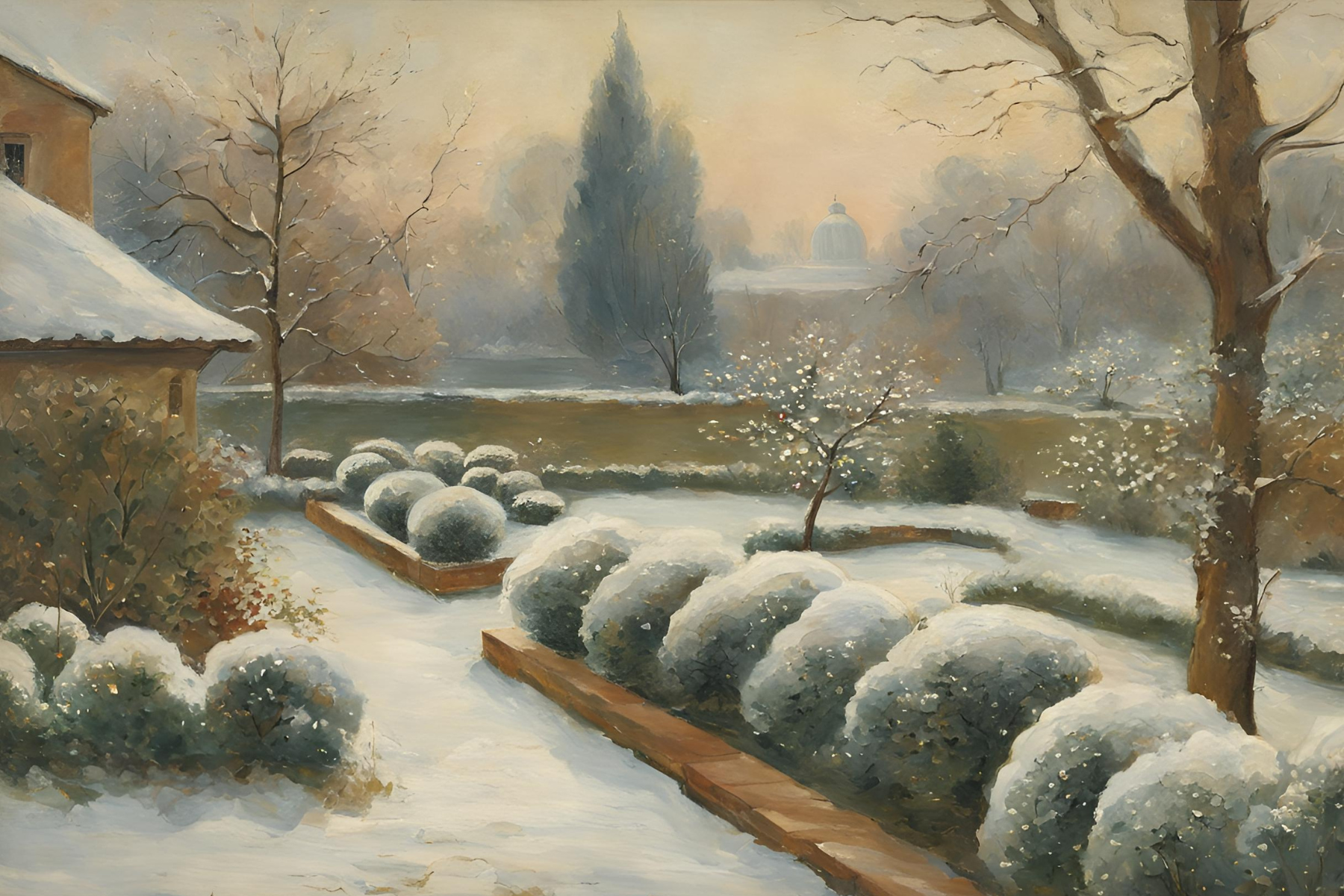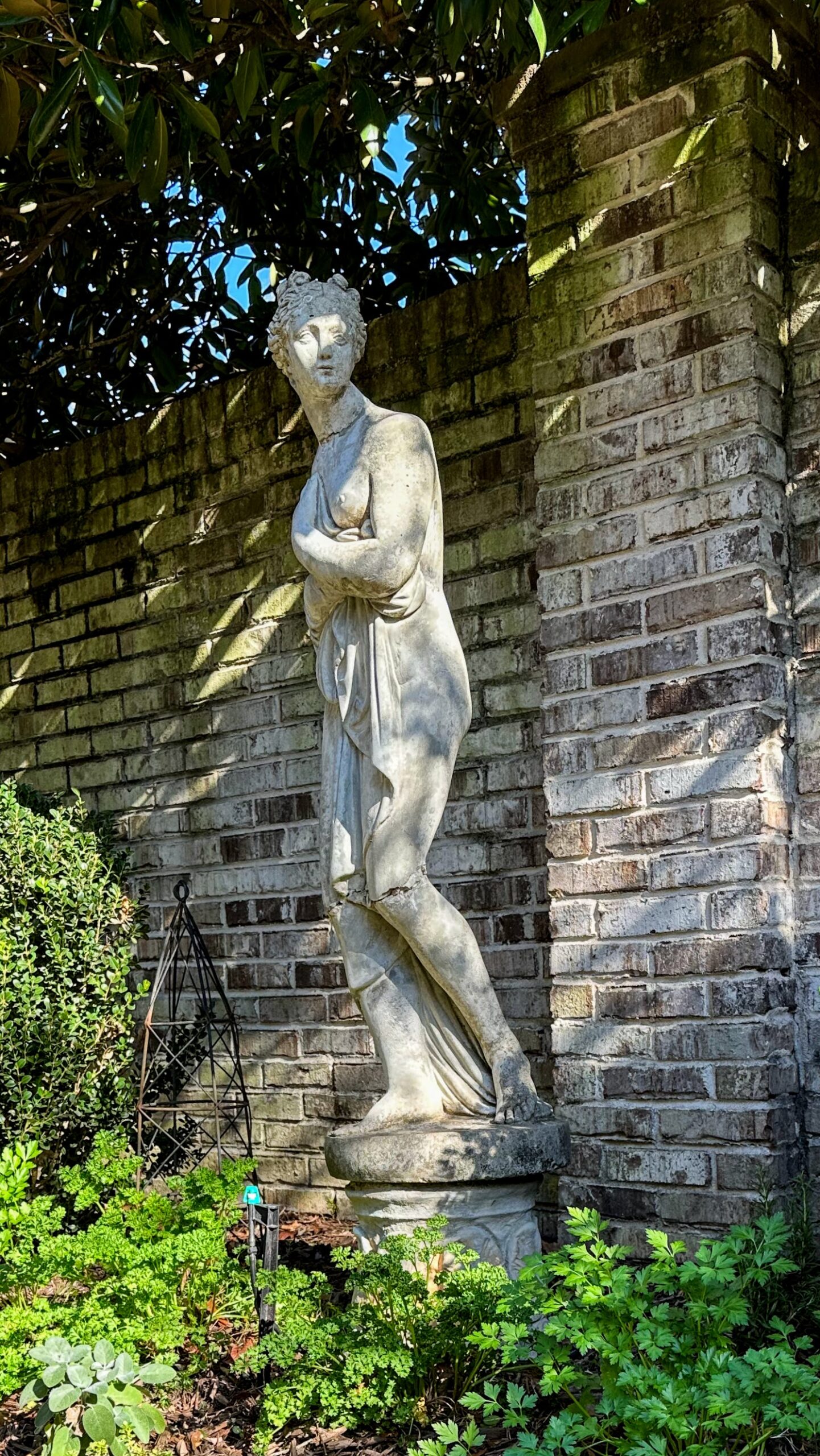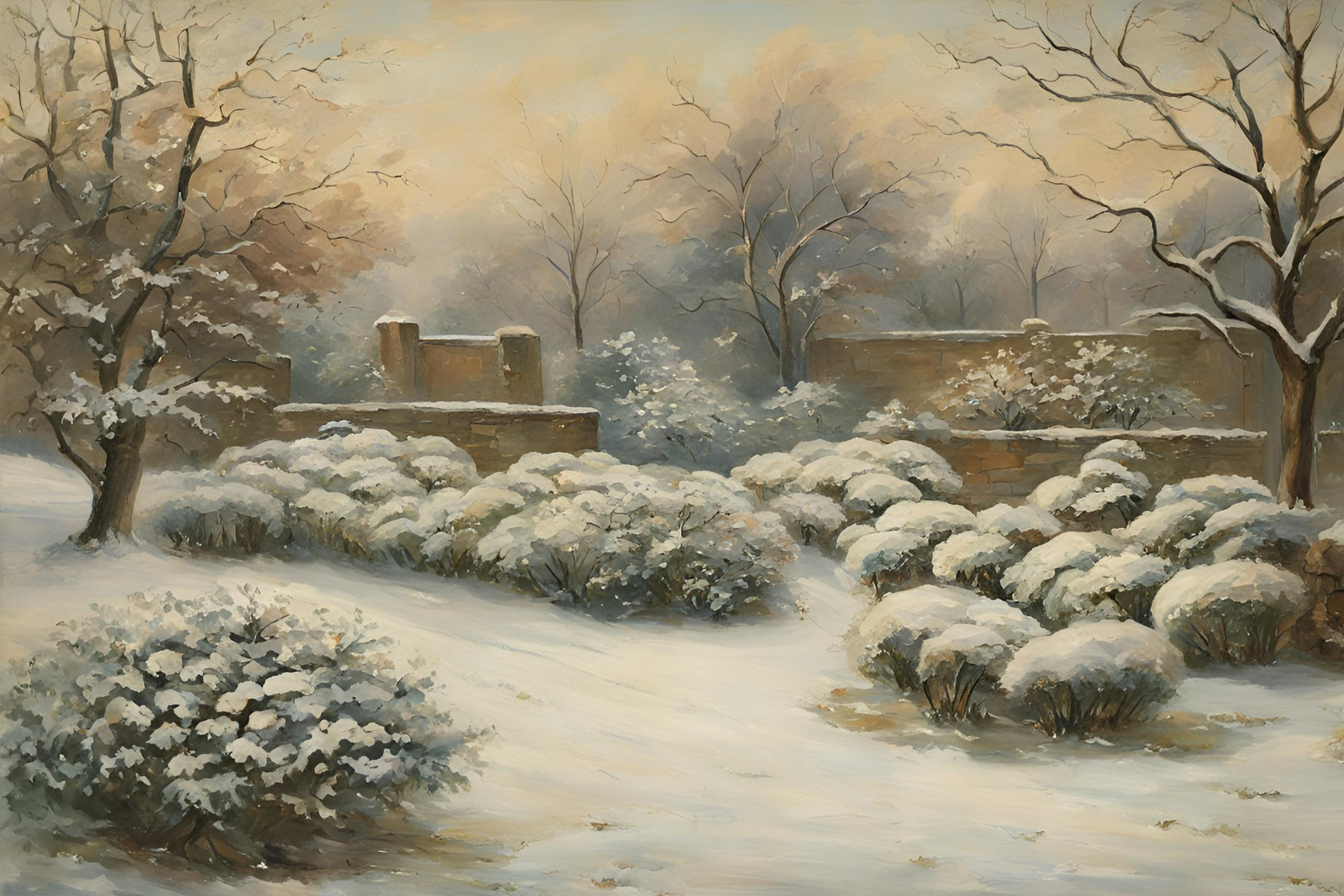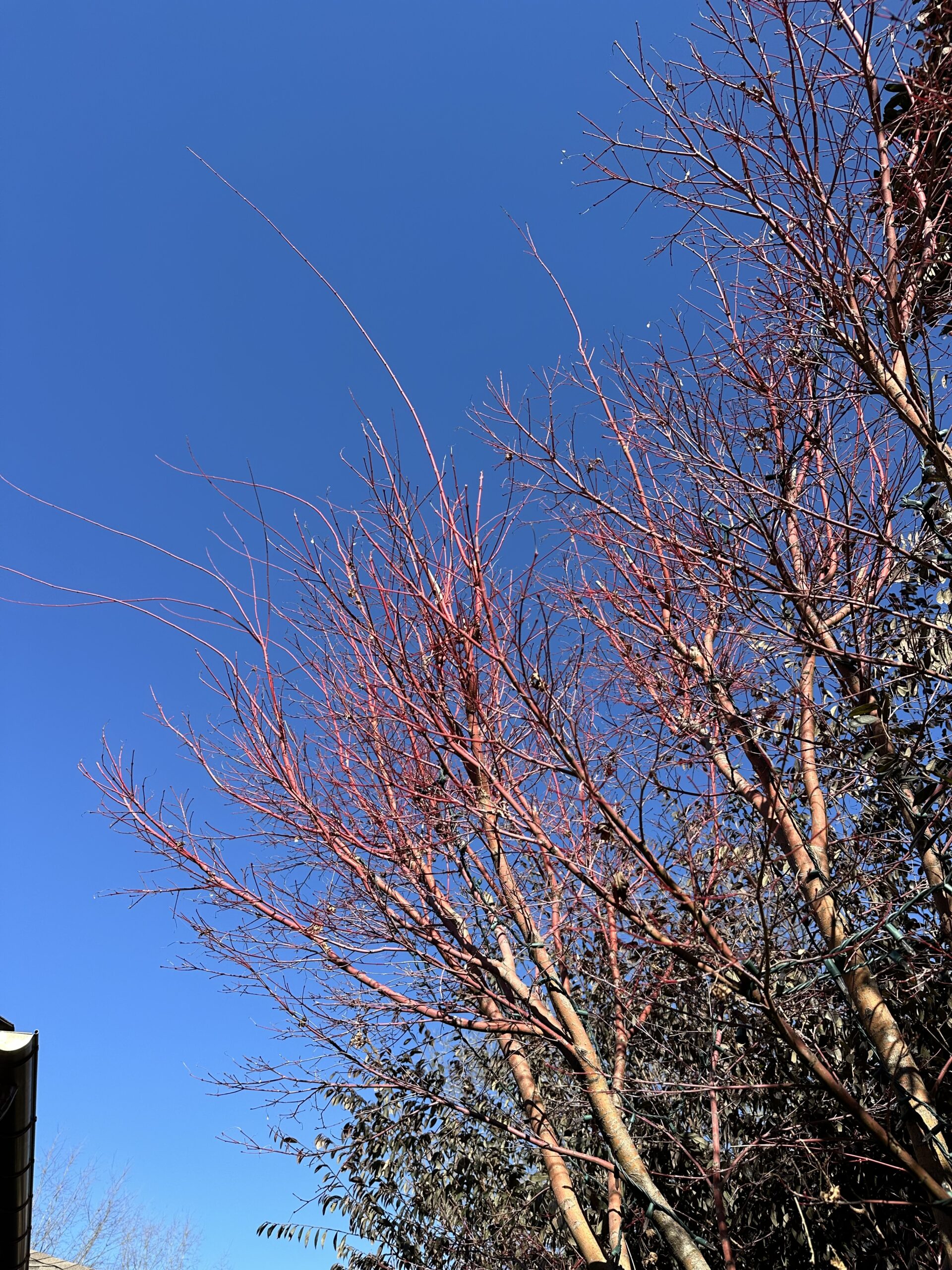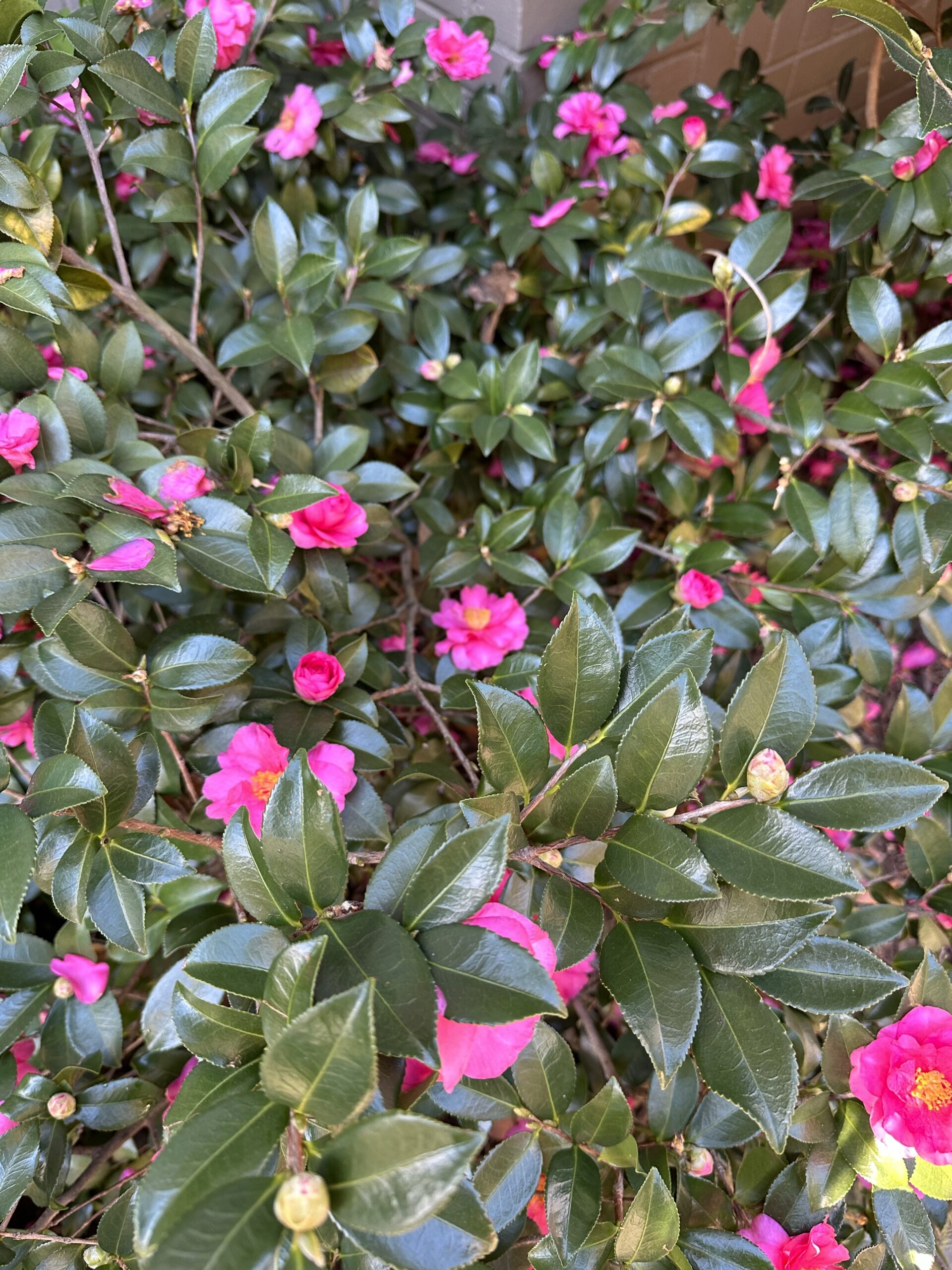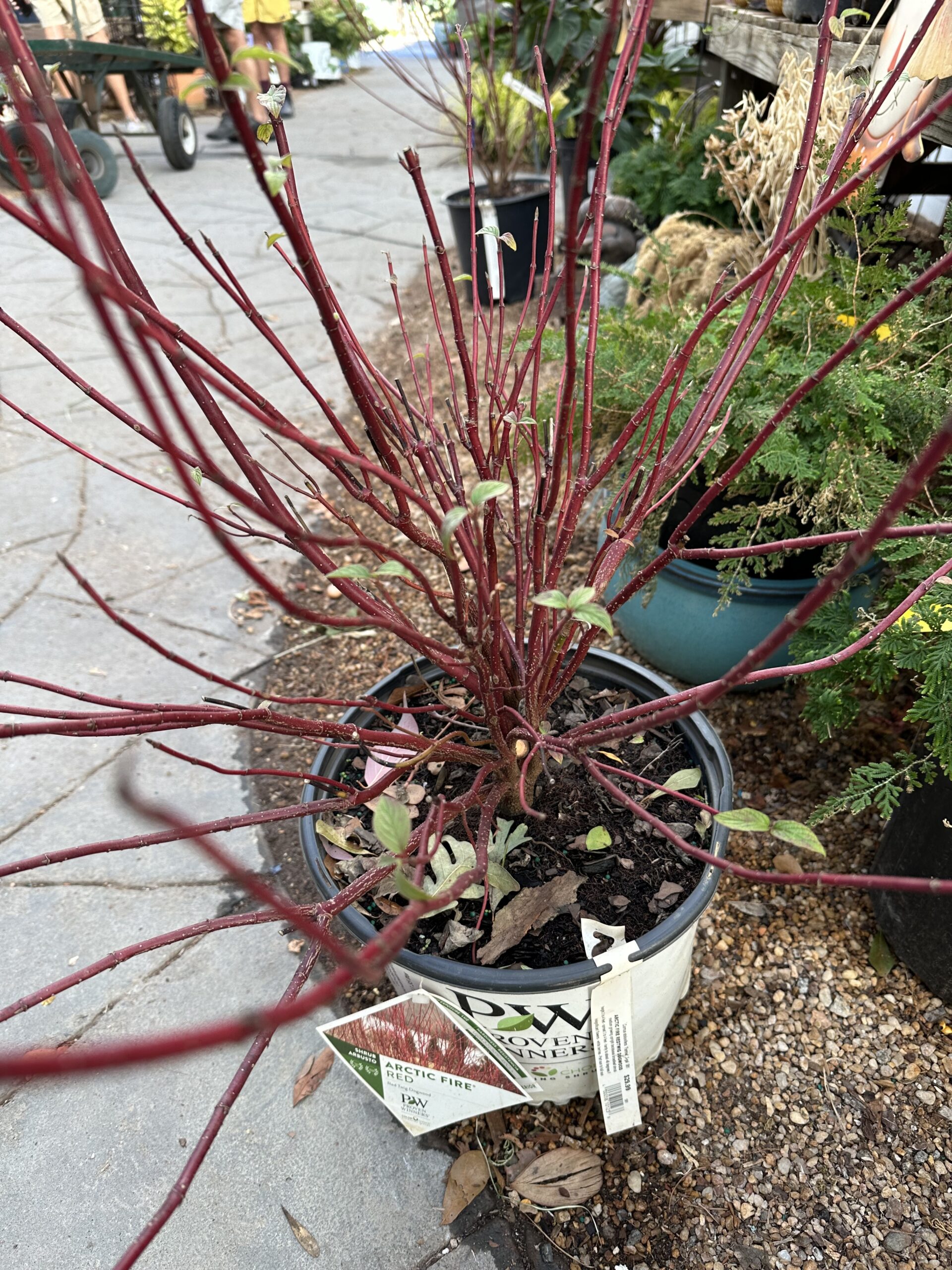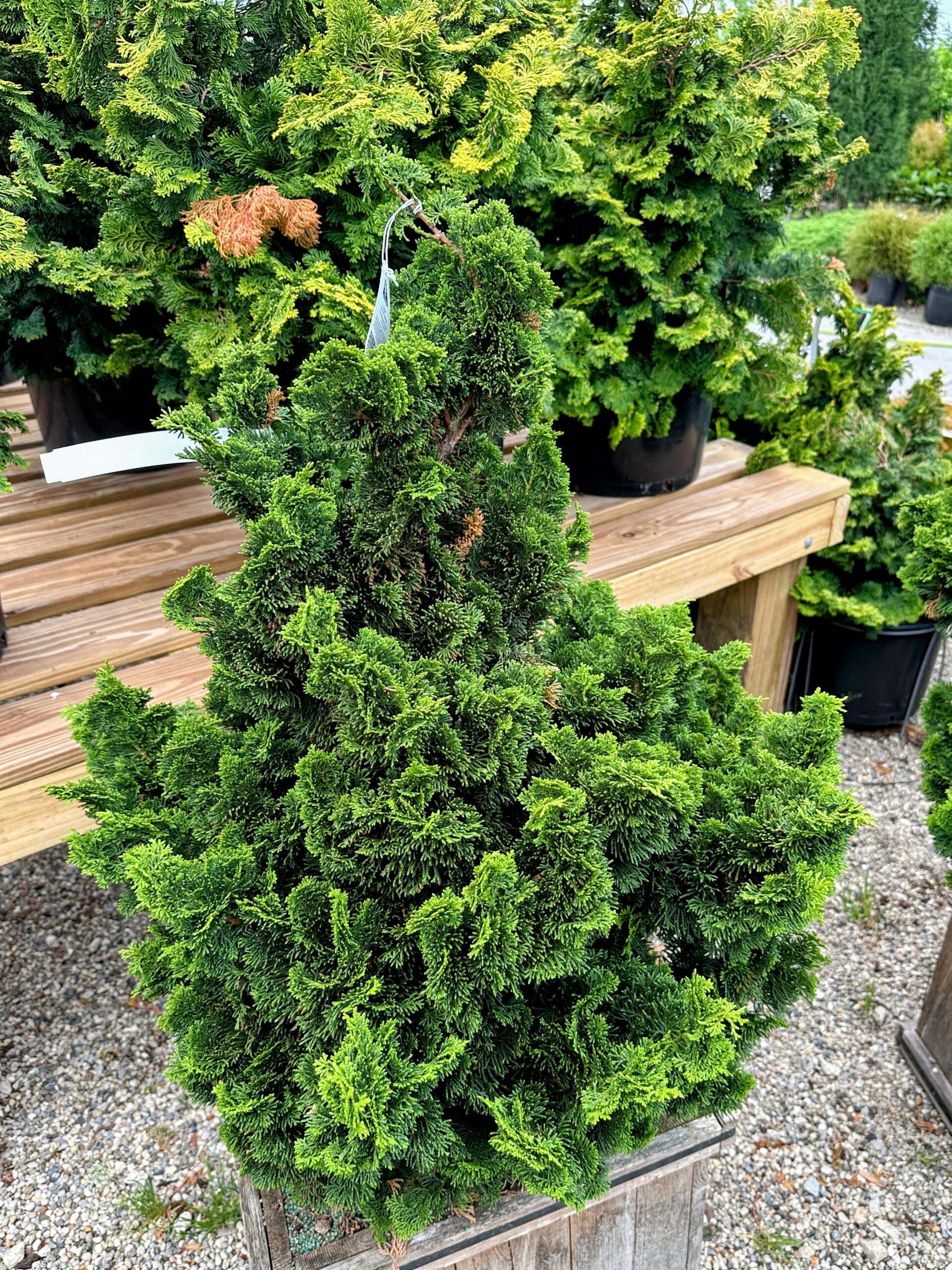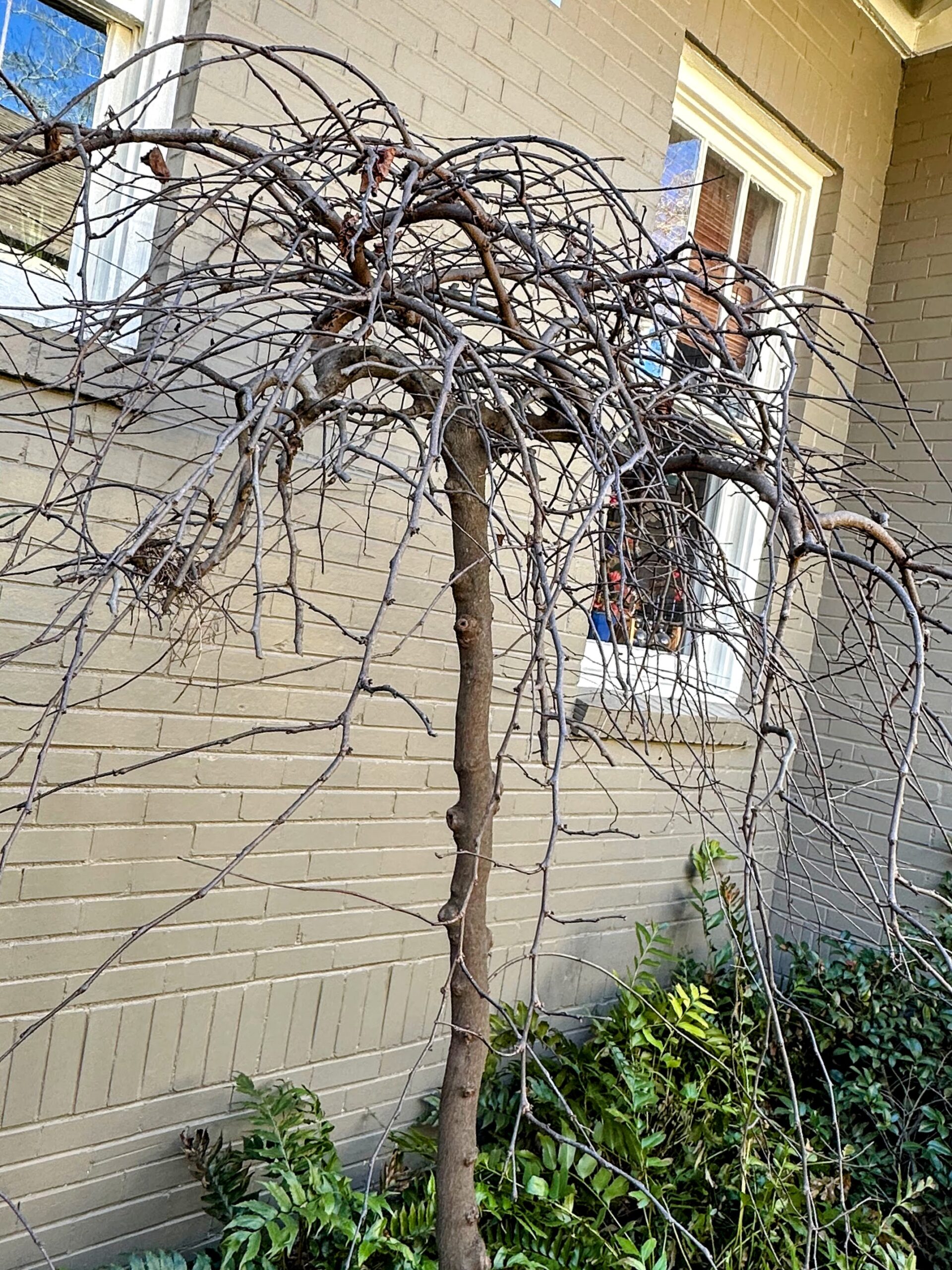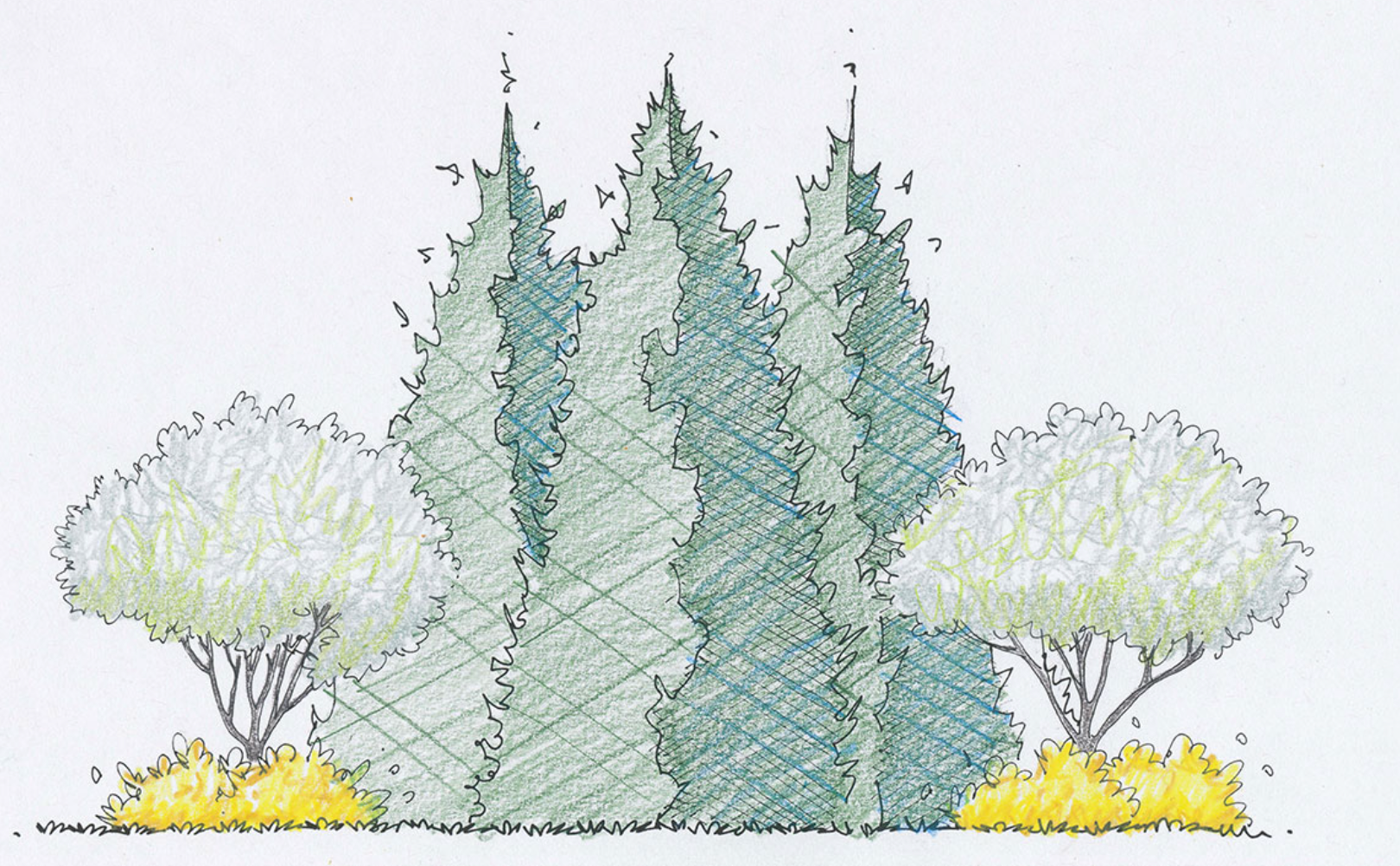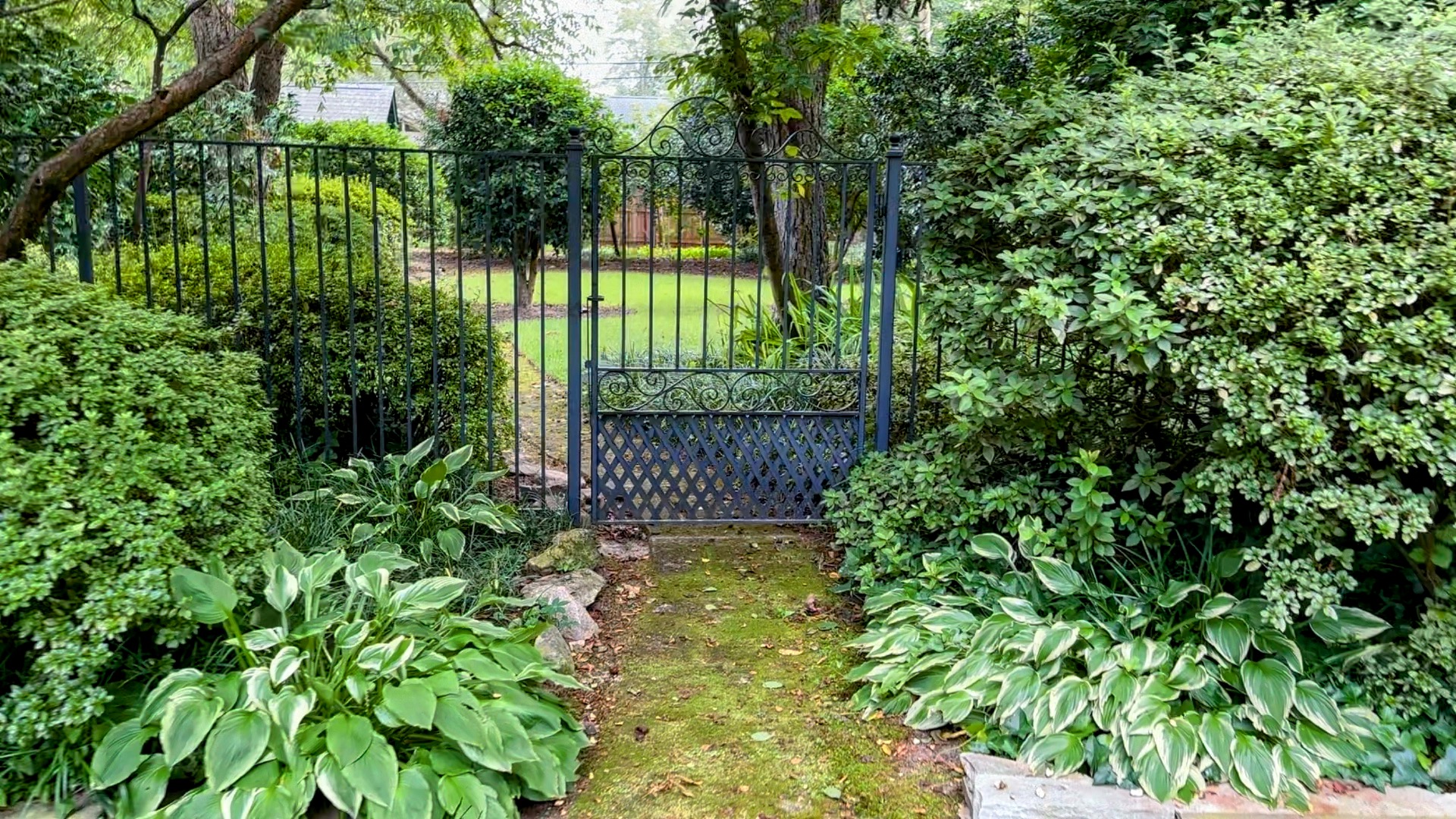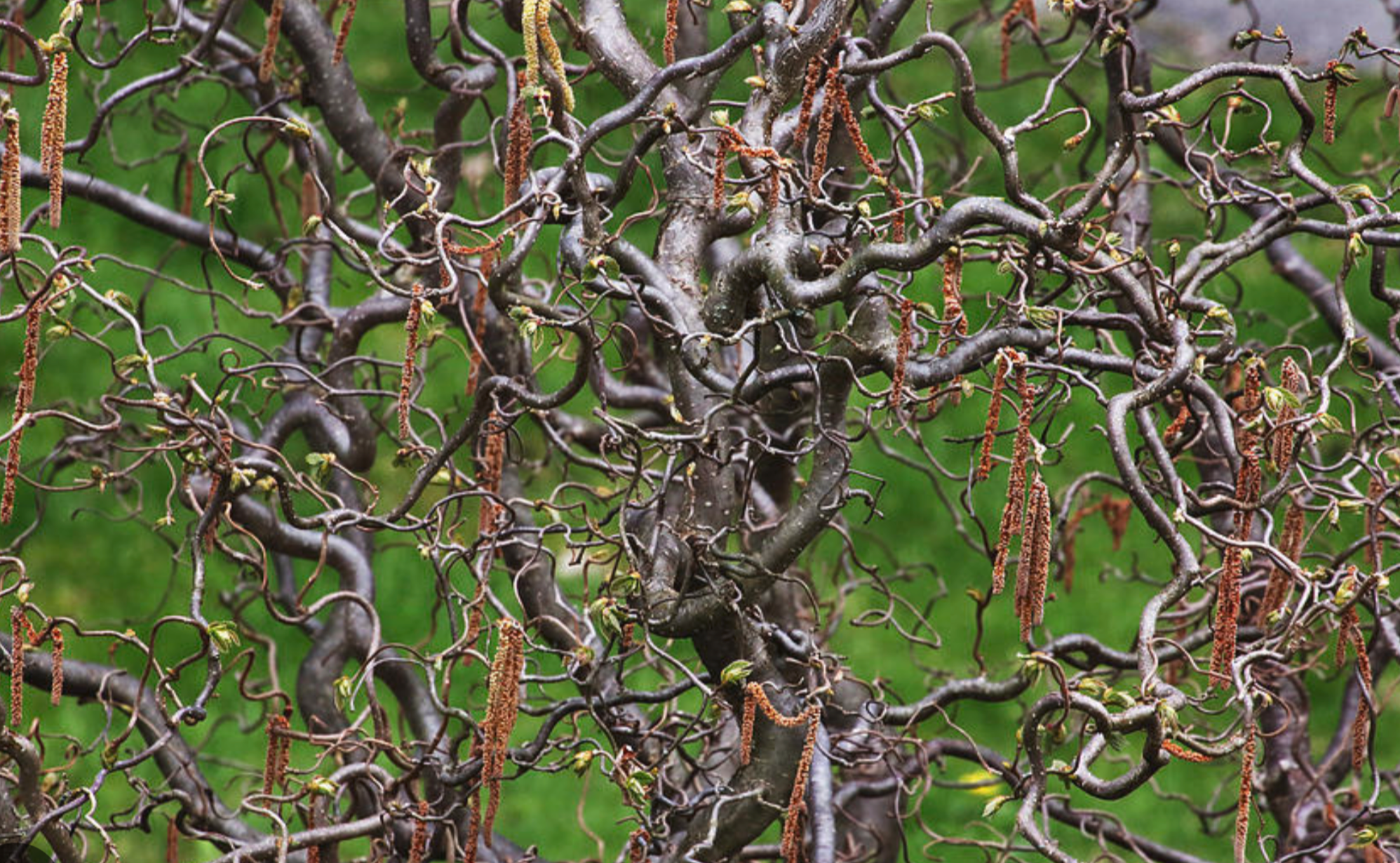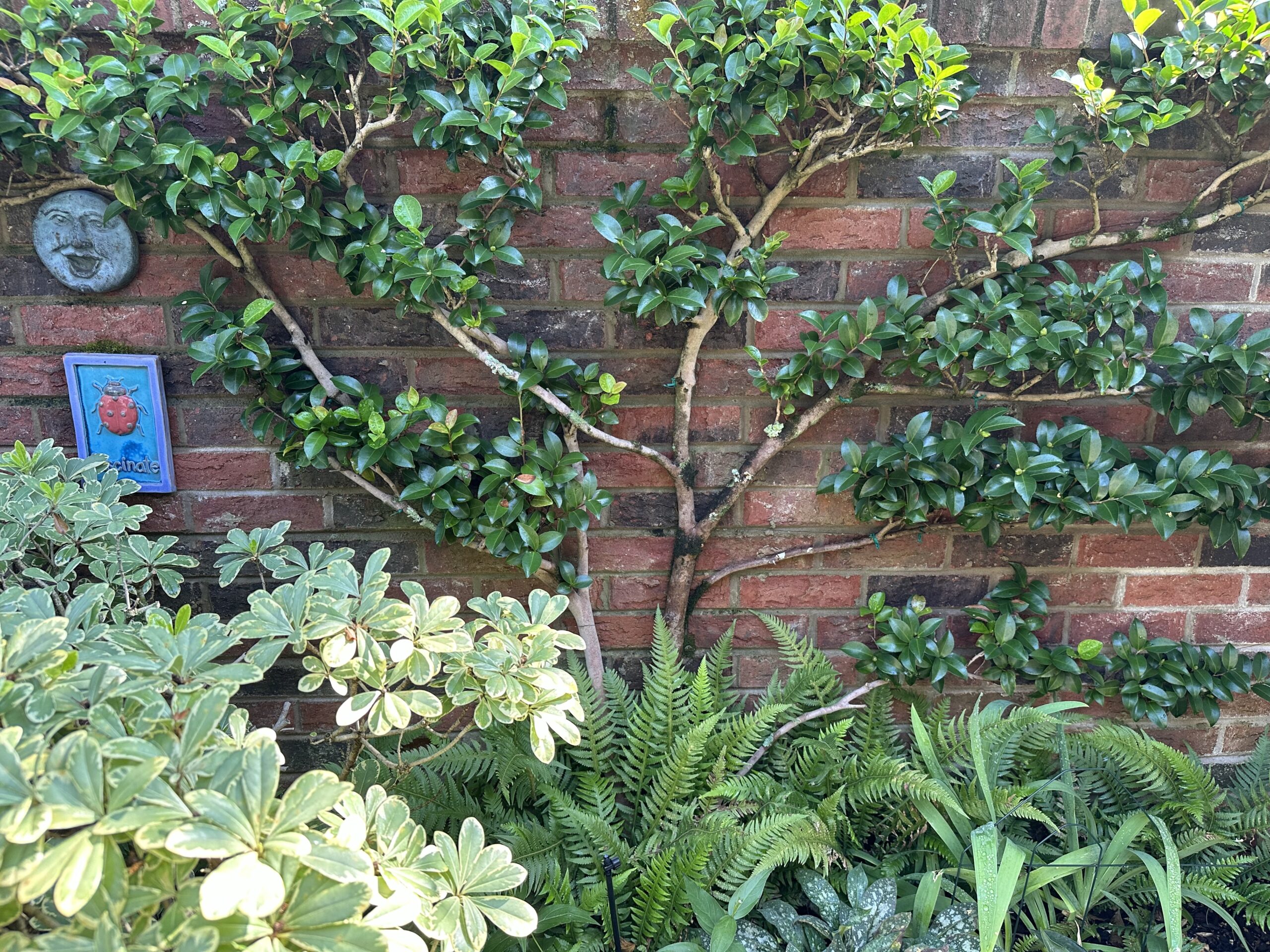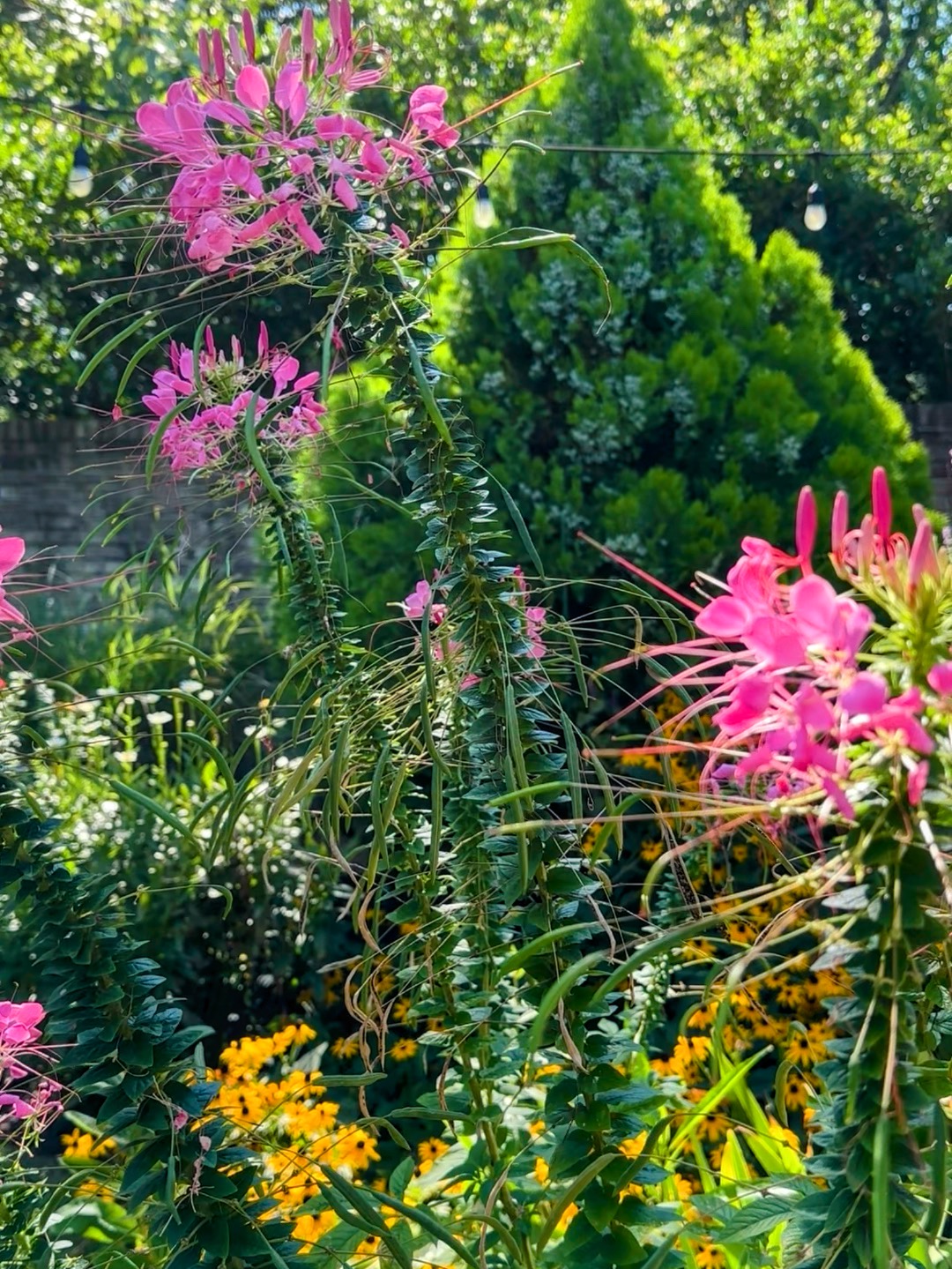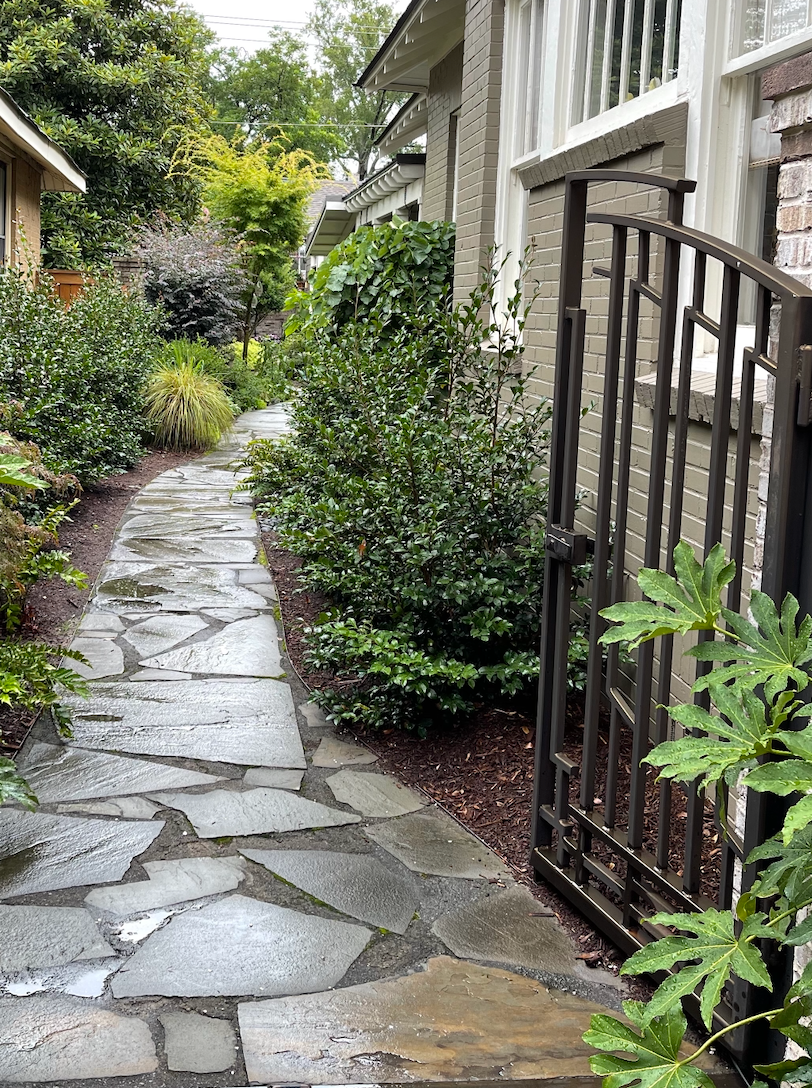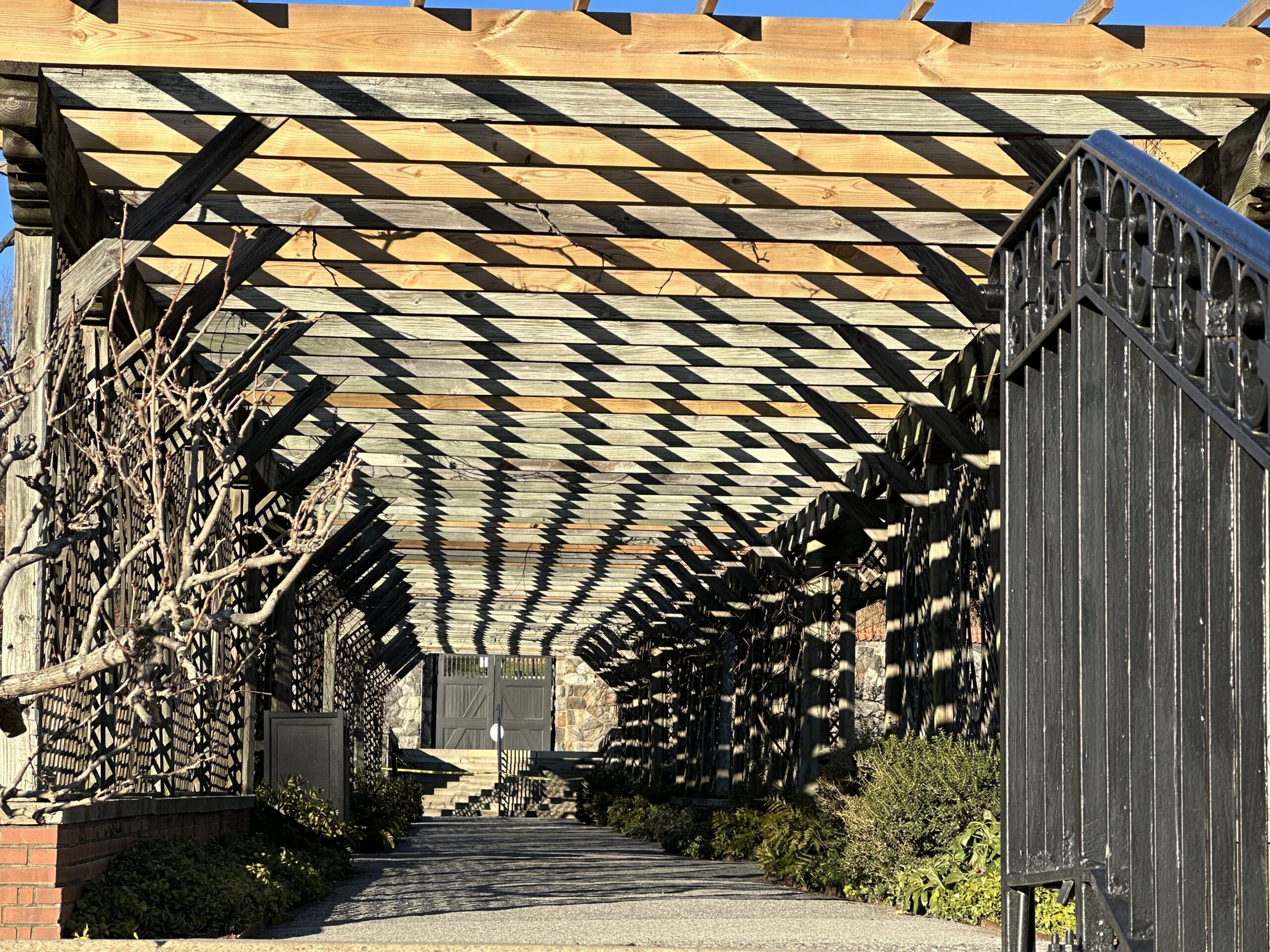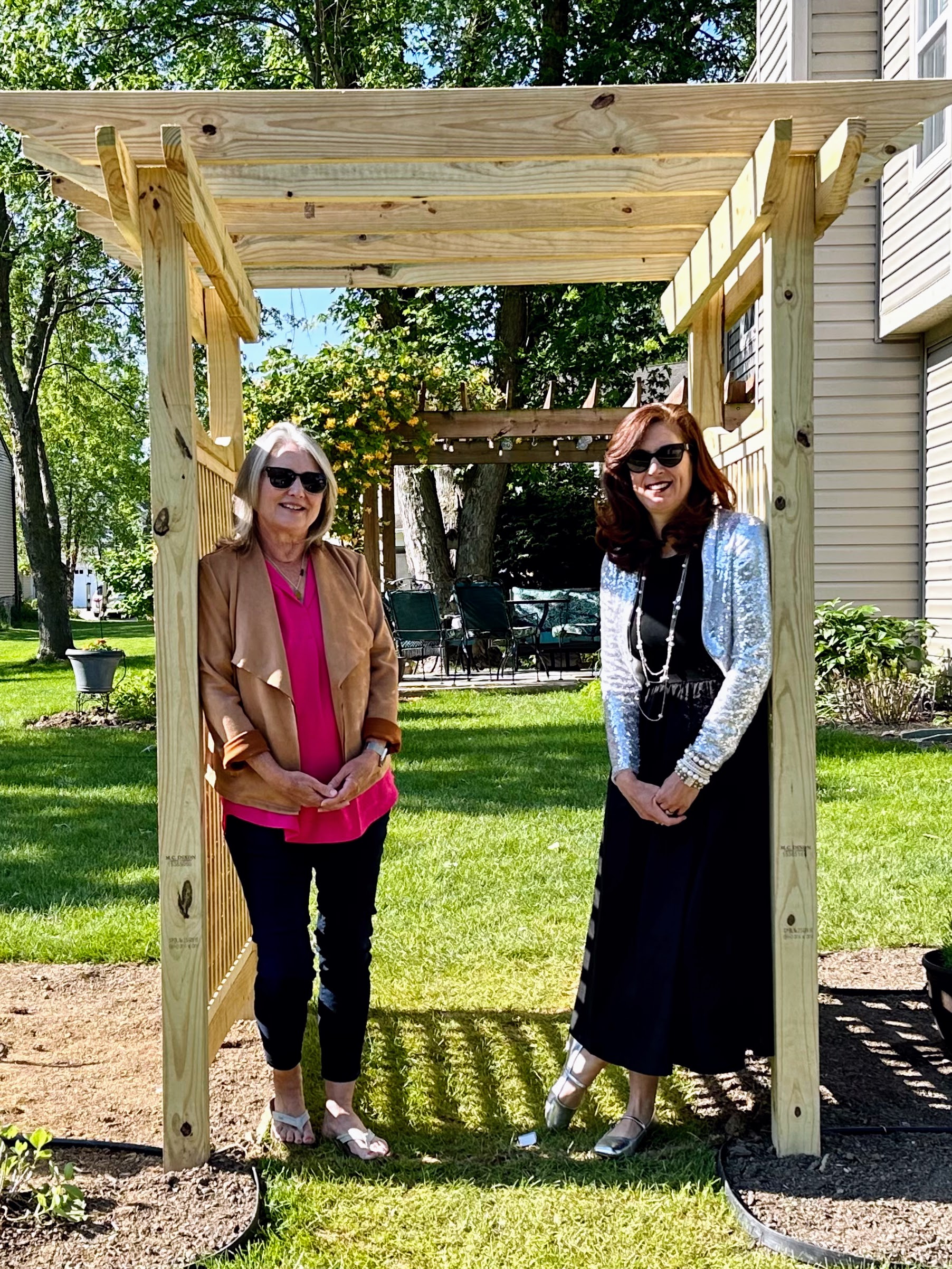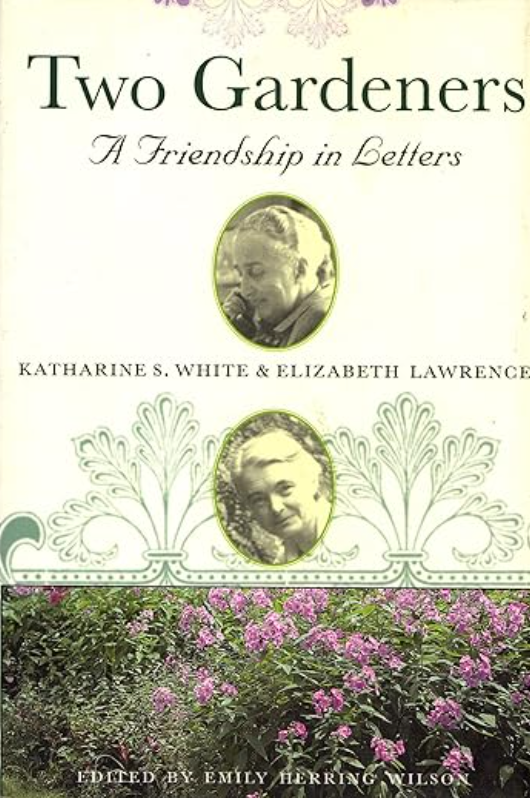Garden Design Series Episode 4
Plan Your Winter Garden First
My mom taught me most of what I know about gardening and garden design. But probably the most important lesson she drilled into me was to plan your winter garden first. Why? Because your winter garden provides the form and structure for your year-round garden. She called it the bones of the garden, and she was right. Just as your skeleton provides structure for everything else in your body, your winter garden provides the structure for what you do the rest of the year.
My mom taught me most of what I know about gardening. I took this photo of her on a trip to Seattle in 2006 to visit her cousin, Tom and her Uncle Viv.
Plan Your Winter Garden First
Most people start with their spring garden…that’s when we plant things, right? We plan the succession of plants and colors from spring through summer and into fall, going for successive waves of color across the growing season.
Then in the winter, everything dies back, and the garden looks bare and forlorn. We sit inside and pore over seed catalogs waiting for spring to come so we can plant again.
Starting with your winter landscape when you are designing a garden encourages you to concentrate on the forms, structures, textures and colors that will provide the bones for your gardens the rest of the year. In planning your winter garden, you create the backdrop for the perennials and annuals that you will cultivate in spring, summer, and fall.
Table of Contents
Navigate back and forth between sections with these links. At the bottom of each section is a link back to the Table of Contents if you want to look around between sections. You can also use the dots at the right of your screen to navigate between sections. Enjoy!
What Will Your Winter Garden Look Like?
How Can You Provide for Color in Your Winter Garden?
Form and Shape in the Winter Garden
Winter Garden Silhouettes Structure Your Year-Round Garden
Man-made Points of Interest in the Winter Garden
in previous episodes…
All the thinking we did in the first three garden design vlogs come together in this fourth episode. To review:
Episode 1: Five Big Questions to Consider Before you Design a Garden. I encouraged you to consider what sort of garden you want, and how much of you (your time and effort) you want to invest. Gardening generally isn’t a spectator sport!
Episode 2: Garden Design One Room at a Time,. Here we explored the idea of outdoor spaces functioning physically and conceptually like rooms. We talked about how important it is to concentrate our efforts on one room at a time so we don’t overwhelm ourselves with allthethings.
Episode 3: Using Line and Shape to Define Space. We explored how lines and shapes are used to create rooms and how these elements form the beds within those rooms. I challenged you to develop your design eye and showed you how to practice doing so. And I showed you how line and shape can lend a particular feel to a space depending on whether you use formal or informal design elements.
Our Lady of Perpetual Nakedness provides structure and interest to my garden all year. Here she is in January of 2023 surrounded by herbs that are still going strong due to the fact that they are protected by my brick fence.
Now it’s time to think about choosing trees and shrubs, benches, fountains, planters, and statuary to build the bones of those rooms and beds, starting with your winter landscape.
What Will Your Winter Garden Look Like?
When the leaves fall from the trees and your flowers get hit by the first hard frost, all that color and green from deciduous trees, perennials, and annuals is gone almost overnight. And what’s left? (I mean other than a lot of cutting back and cleaning up?)
What’s left is the bones. Even in climates where it snows as in the image below, the trees, shrubs, and hardscaping elements that structure the landscape and form your outdoor rooms are on full display. While we talked in previous episodes about using line and shape and structural elements to build rooms and beds, now we will X-ray our gardens and examine the bones.
We’ll look at color, form, shape, hardscaping, and decorative points of interest in the winter garden. If you’re thoughtful, your winter landscape can provide you with as much beauty–although a more subdued beauty–as it does the rest of the year.
In winter, a garden reveals its “bones.” Even covered in snow, this garden is beautiful.
Color in the Winter Garden
In winter, my garden features gorgeous evergreen color provided by arborvitae, ligustrum, variegated pittosporum, and camelias. Loropetalums retain their purplish leaves all winter, and my neighbor’s magnolia displays its shiny green foliage over the brick wall. In the Dooryard, although it has lost its leaves, the Japanese maple’s red twigs show brilliantly against the Carolina blue sky. In late January and February (depending on the winter weather) the camelias bloom white and pink—just when we need a boost to get through the rest of the winter.
Even the curved grass carpets in The Refuge and The Front Room turn a golden brown providing a different type of interest during the winter against the brown mulch in the beds. In The Front Room, boxwoods, autumn ferns and creeping myrtle continue to provide color all winter, as does the porch furniture with its colorful cushions.
Regardless of where you live, you can plan for color in your winter landscape. Plant evergreens for year-round color along with plants with colored twigs. If you live in a temperate climate, or have a sheltered spot, add winter pots for pops of color.
The red twigs on this Japanese maple is gorgeous in winter against the sky
Cameilias display shiny green foliage year round and bloom pink and white in late winter
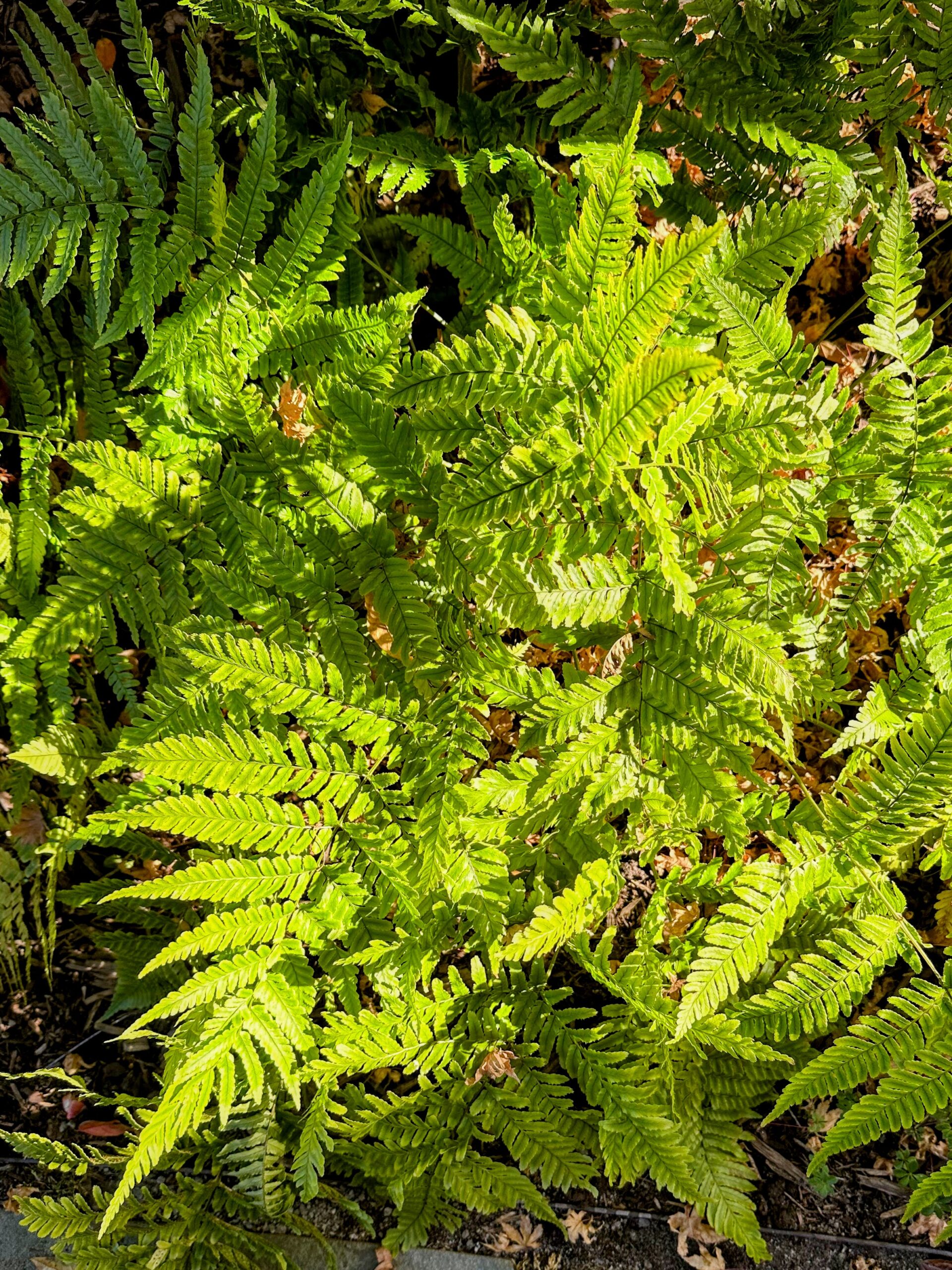
Autumn ferns in February
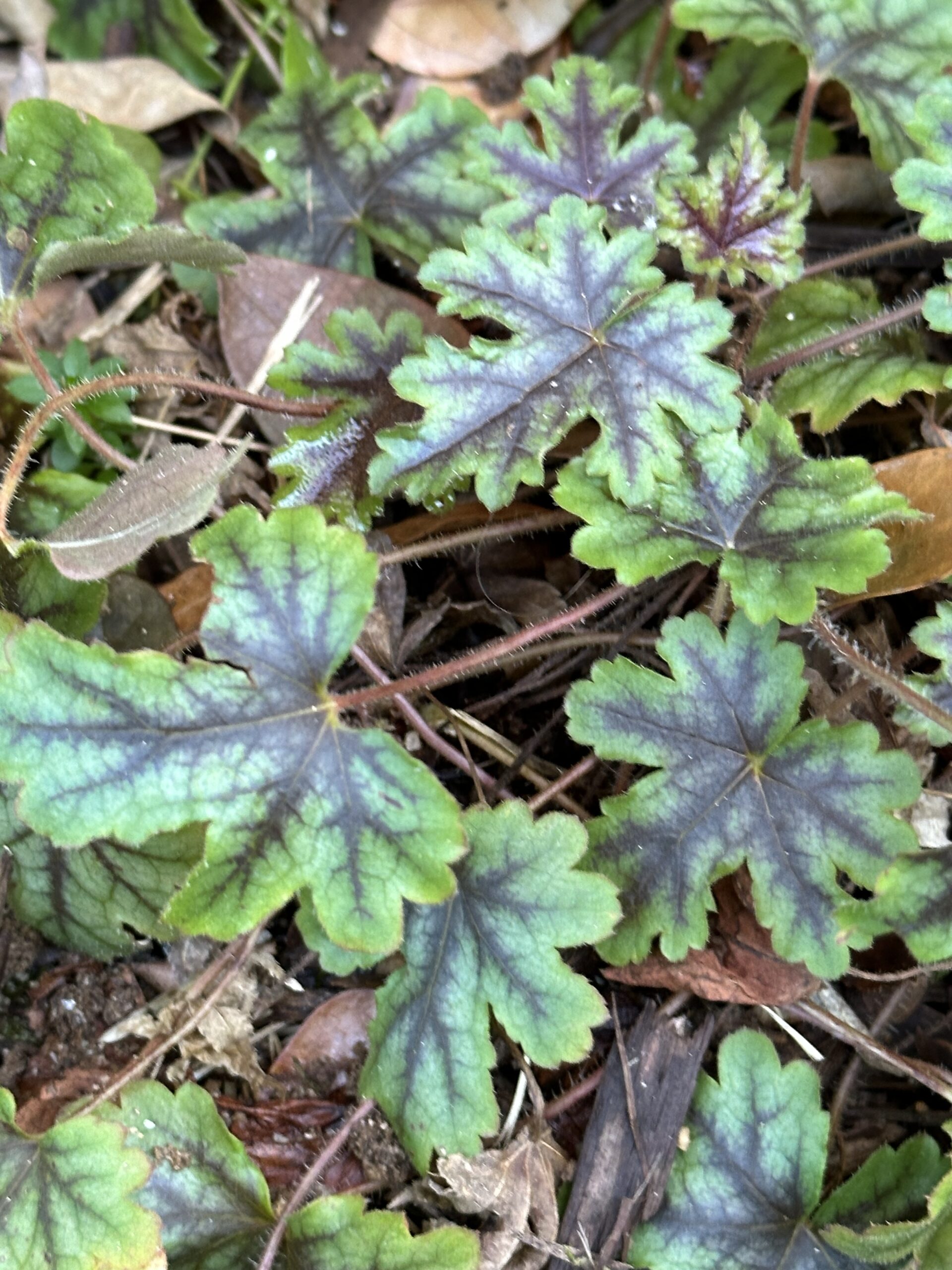
Coral Bells (Heuchera)
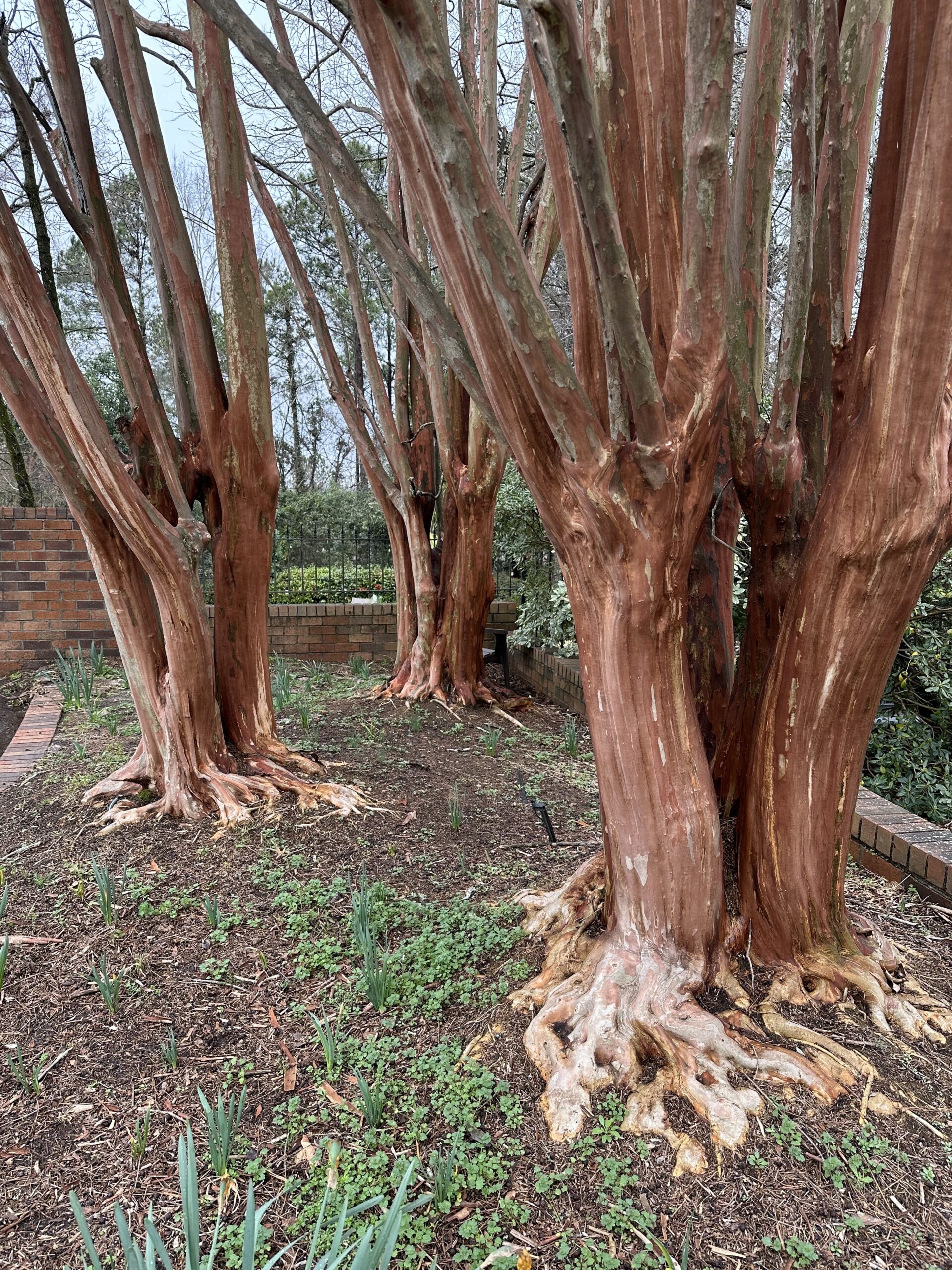
Crepe myrtles in winter
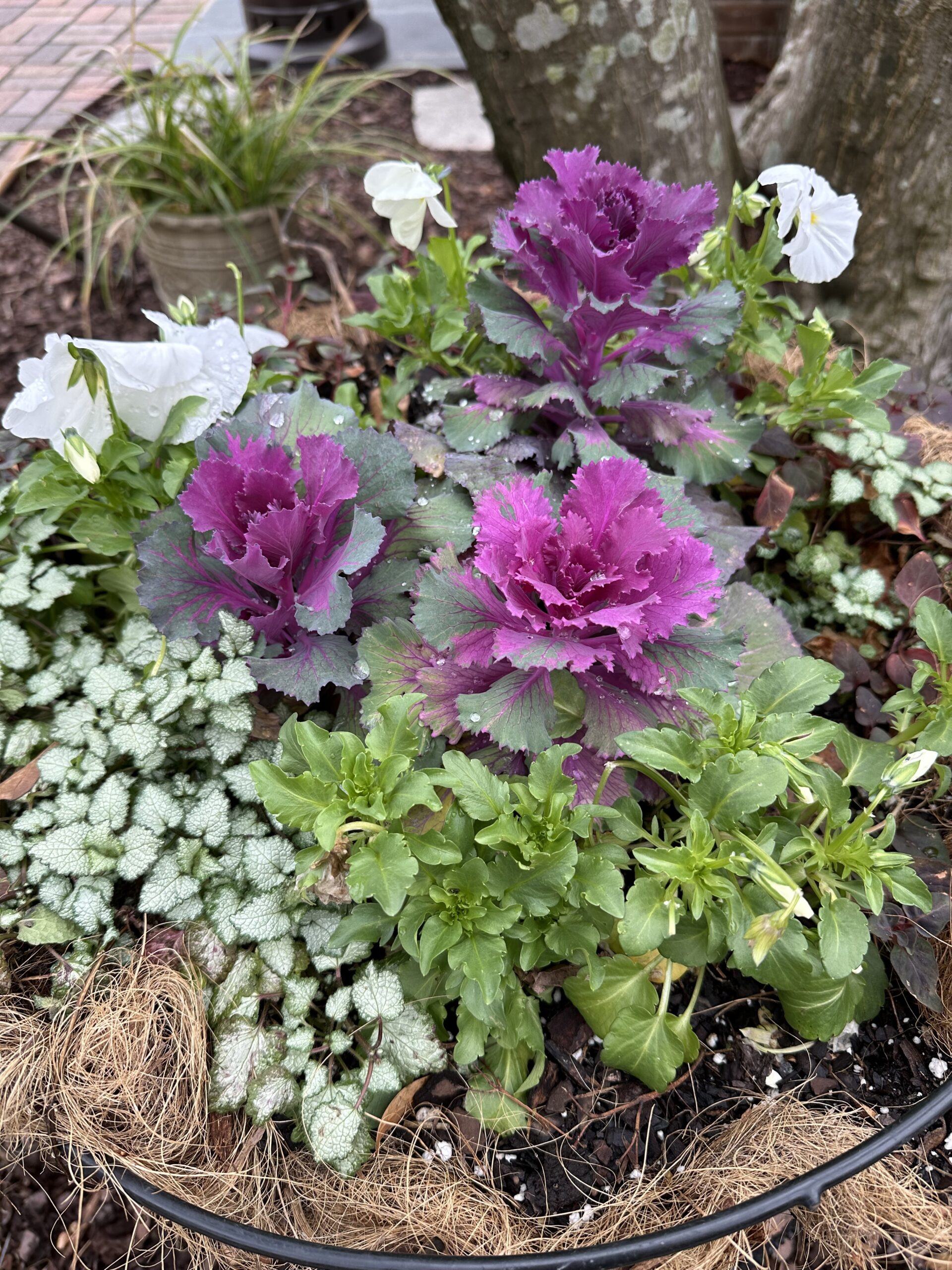
Ornamental kale, lamium, and pansies
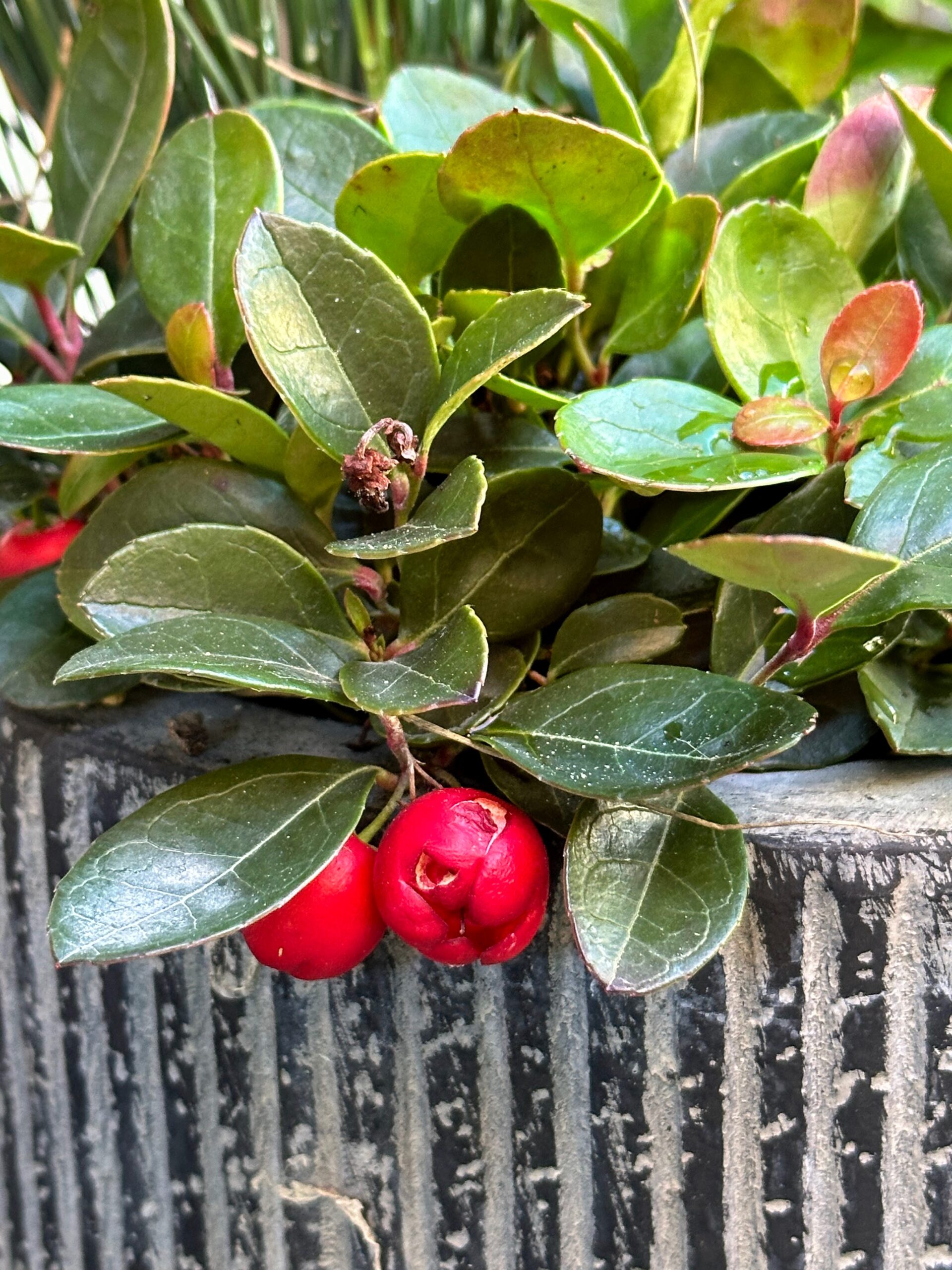
Evergreen ivy and Wintergreen
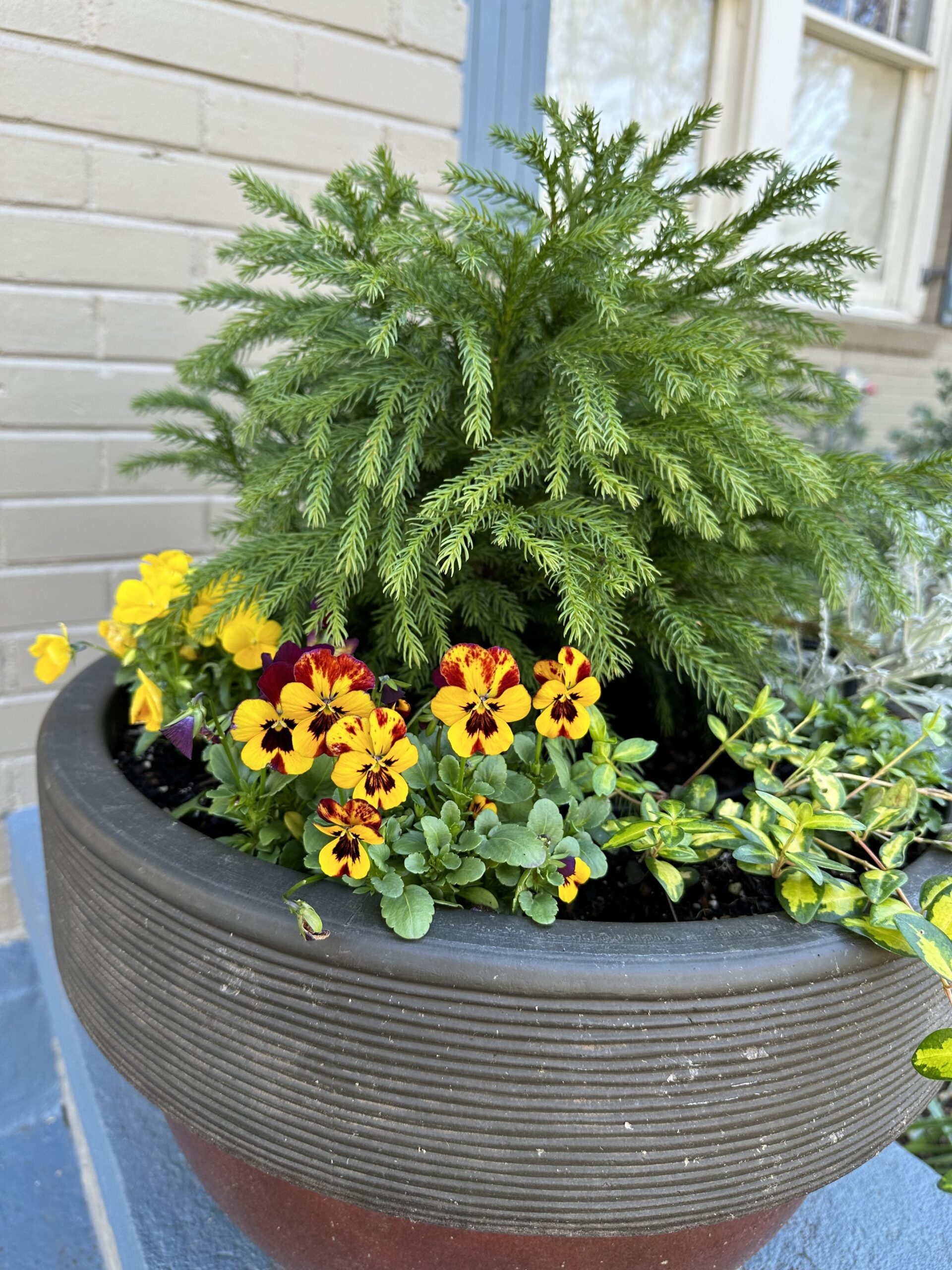
Dwarf Cryptomeria underplanted with Johnnie Jump-ups
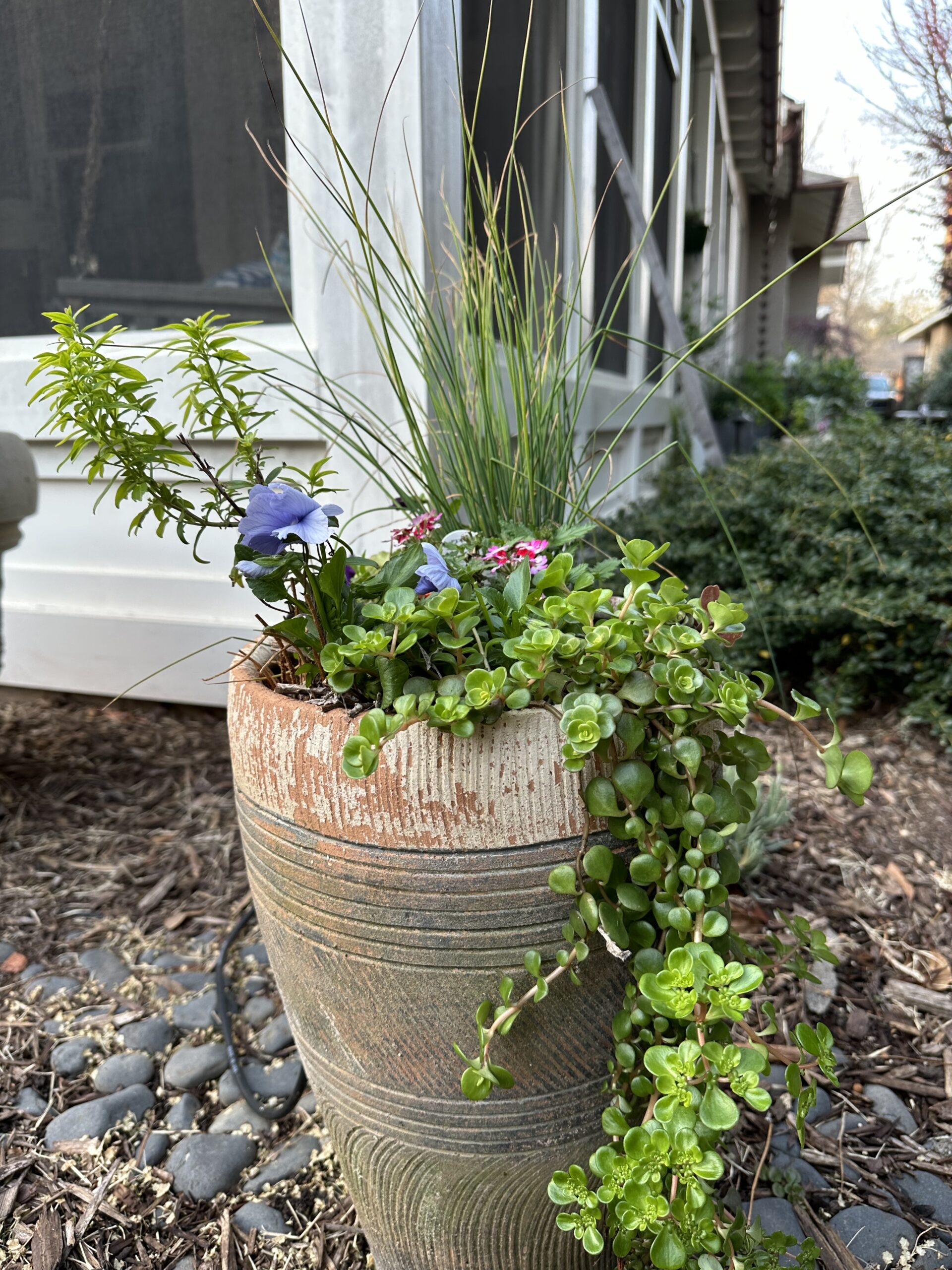
Pot planted with perennial grass, sedum, and pansies
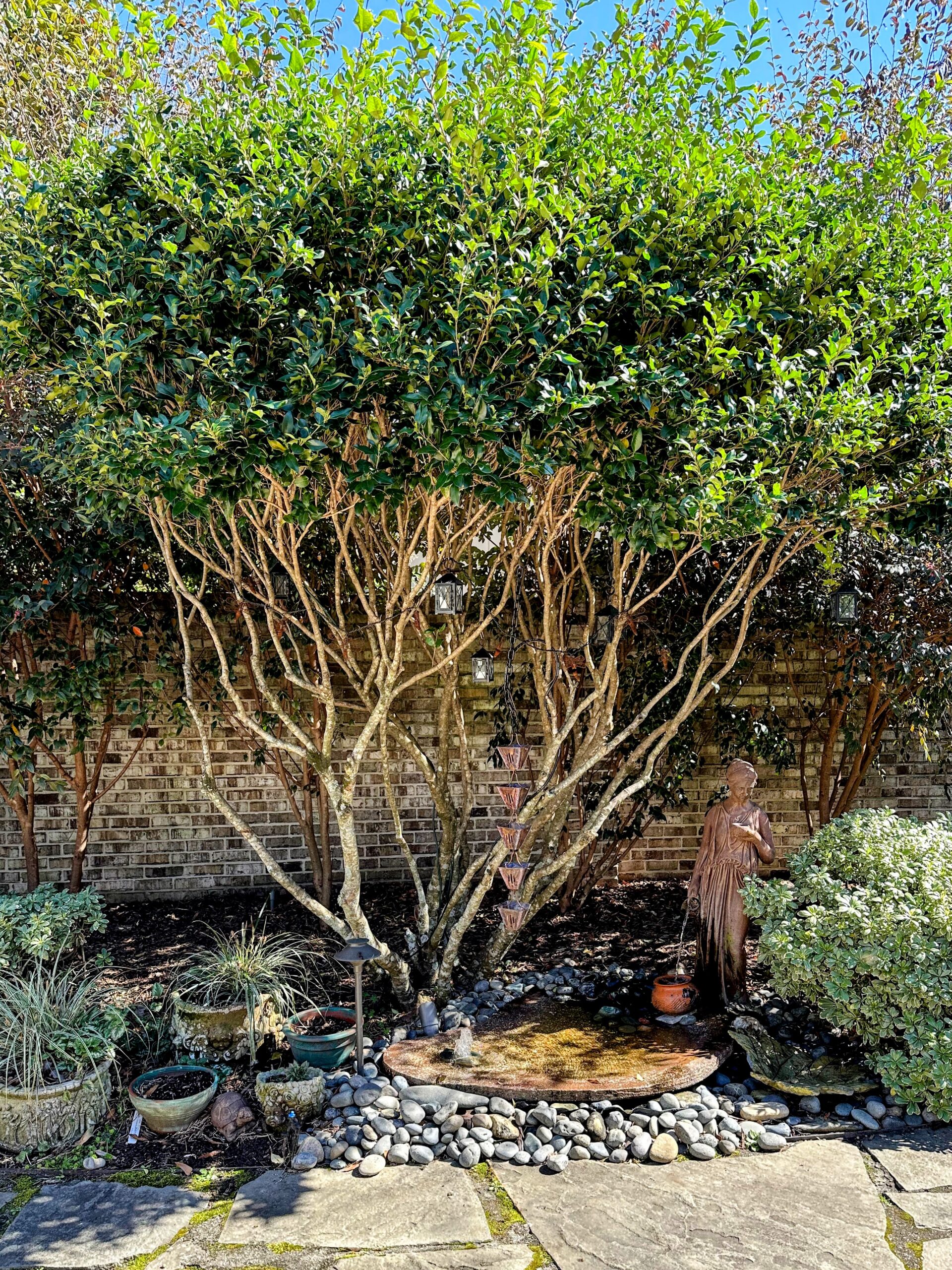
My Lady Fountain in winter is surrounded by evergreen ligustrum and variegated pittosporum
How can you provide for color in your winter garden?
What trees and shrubs grow well in your zone that would add color and interest to your landscape? Look for evergreens as well as trees and shrubs with interesting branch colors (red twig dogwood is a good example).
Here are two things you can do as you design your winter garden:
1) Go on an online nursery crawl to do some exploring. Make a list of the things you like and what it is you like about them. Be sure to note both common and Latin names so you can look for them locally when the time comes.
2) Take a drive around your area and see what others have planted that you like. Take lots of pictures and take notes.
Caution: do your research before you buy! Don’t get swept up into whatever the fad of the decade is or whatever seems popular. Look for species that are native to your area where possible; they are less prone to disease and problems. I have a lot of non-natives in my garden; if I had it to do over again, I would make different choices…
Do your research before you buy. Read the tags on plants you find locally, take notes, then go online and cross check with online nurseries. Consider your site and what it offers in terms of protection from the summer heat and winter cold.
Red twig dogwood
Go on a local nursery crawl to see what is available in your area. Read the tags carefully and take notes.
Form and Shape in the Winter Garden
I use the words shape and form to refer to the silhouette created by a plant, tree or shrub. Evergreens provide not only color but they add structure and interest in the winter garden with their different shapes and forms. The deciduous trees and shrubs in my gardens also provide interest once their leaves are gone, creating lovely silhouettes. My crepe myrtle’s gorgeous reddish brown branches remind me of arms and fingers reaching up toward the sky. And my collection of Japanese maples of all sizes each have beautiful and different forms that draw the eye. When the leaves fall off my Weeping Redbud, its weeping branches are, well, sculptural.
My weeping redbud in winter, underplanted with holly ferns that stay green all year
The silhouettes created by the various forms and shapes in your landscape provide structure and interest. (Diagram from the Arbor Day Foundation)
My tree-formed ligustrum rises above my Lady Fountain allowing a view through the branches of the brick wall behind it. Mounds of variagated pittosporum also keep their shape and color all year.
A mature garden with good bones. I love the juxtaposition of all the different shapes, colors, and textures in Peggy’s garden.
A Harry Lauder’s Walking Stick provides interest all year.
Winter Garden Silhouettes Structure Your Year-Round Garden
Your winter garden will look different depending on what zone you live in. But regardless of where you live, it’s important to get your bones in place before you figure out the plants you will grow seasonally that will die back in your garden come winter.
Pay attention to shape and form of both evergreen and deciduous trees and shrubs. Read the descriptions of plants carefully and be on the lookout for trees and shrubs with interesting colors and shapes when they lose their leaves. Tall and columnar, round, conical, weeping forms, and curly forms are all great additions to any landscape.
In a yard even smaller than mine, this crafty gardener used the same plants–ligustrum and pittosporum. But the ligustrum has been espaleired–pruned to grow flat against the wall.
This photo was taken in early September. You can see how the conical form of the arborvitae provides a beaurtiful emerald-green backdrop for the cleome and black-eyed Susans, making them pop in the late afternoon sun.
What are the shapes and forms of the trees and shrubs you are seeing in your online nursery crawls and drive-abouts? Make notes and do some sketching. What ideas does this give you for your winter garden? What’s on your wish list now?
The gate, columns, and walkway all provide structure and become points of interest in the winter when the landscape is more subdued.
Man-made Points of Interest in the Winter Garden
Hardscaping provides both structure and interest in the winter garden. My brick wall, the metal gate, and the curved stone walkway all provide structure but also become points of interest in the more subdued winter environment. The fountains and statuary, the seating area in the Dooryard and the garden bench and birdbath in the shade garden continue to provide interest (although when it gets really cold, I have to take the fountains offline). Any planters I leave out all winter are planted with winter annuals to provide pops of color; others are moved into storage.
Time to Poke Around…
What features structure your space and provide interest in your garden? What points of interest could you create using items you already have or items you could repurpose? Visit some local gardens and notice the features they use as points of interest. (Note that benches are easy to come by and usually inexpensive.)
Go to local salvage stores and secondhand stores and walk through with an eye toward things you could repurpose to provide points of interest in your garden.
Consider building a recirculating DIY fountain or waterfall.
Most of all, remind yourself to take the time to see past the present to the possible, and don’t get intimidated by the scale of things as you are looking around for ideas—the arbor walkways at the Biltmore Conservatory is a good example. We used the same idea to build a much smaller arbor entry into Rich and Katie’s back room—same idea, different scale.
You may be inspired by things in grand gardens…don’t be intimidated. Scale things to fit your space and see if they work.
Katie’s arbor is scaled to fit her space.
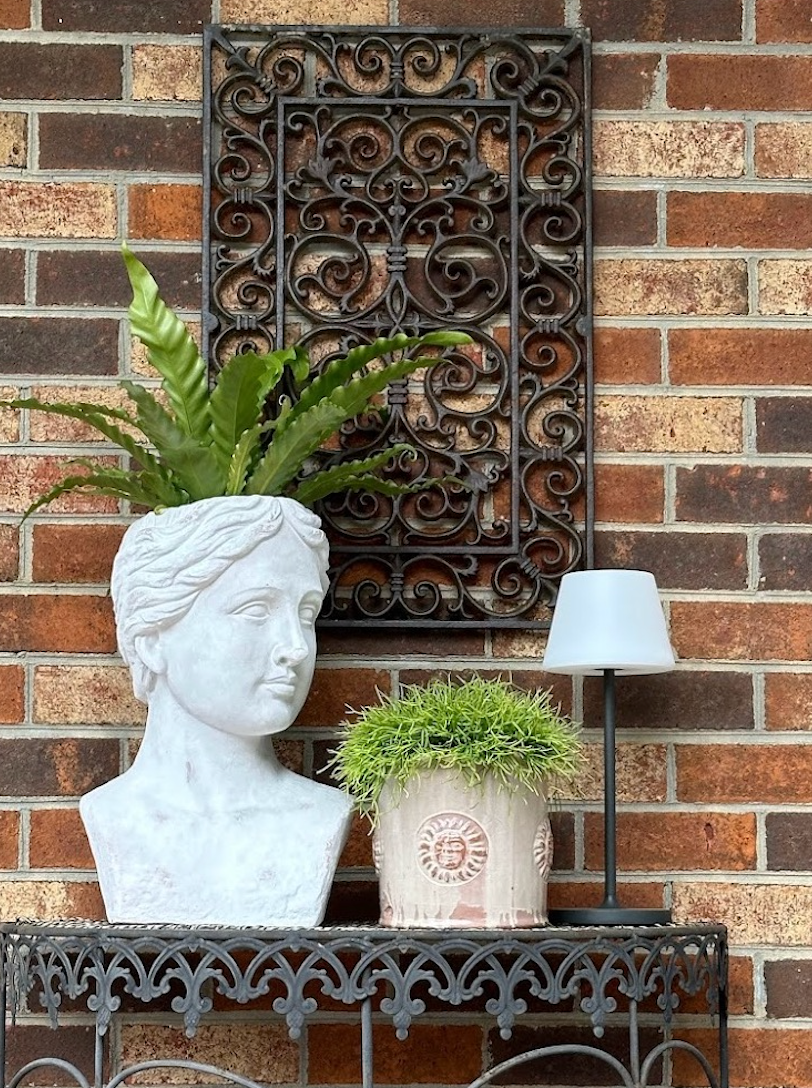
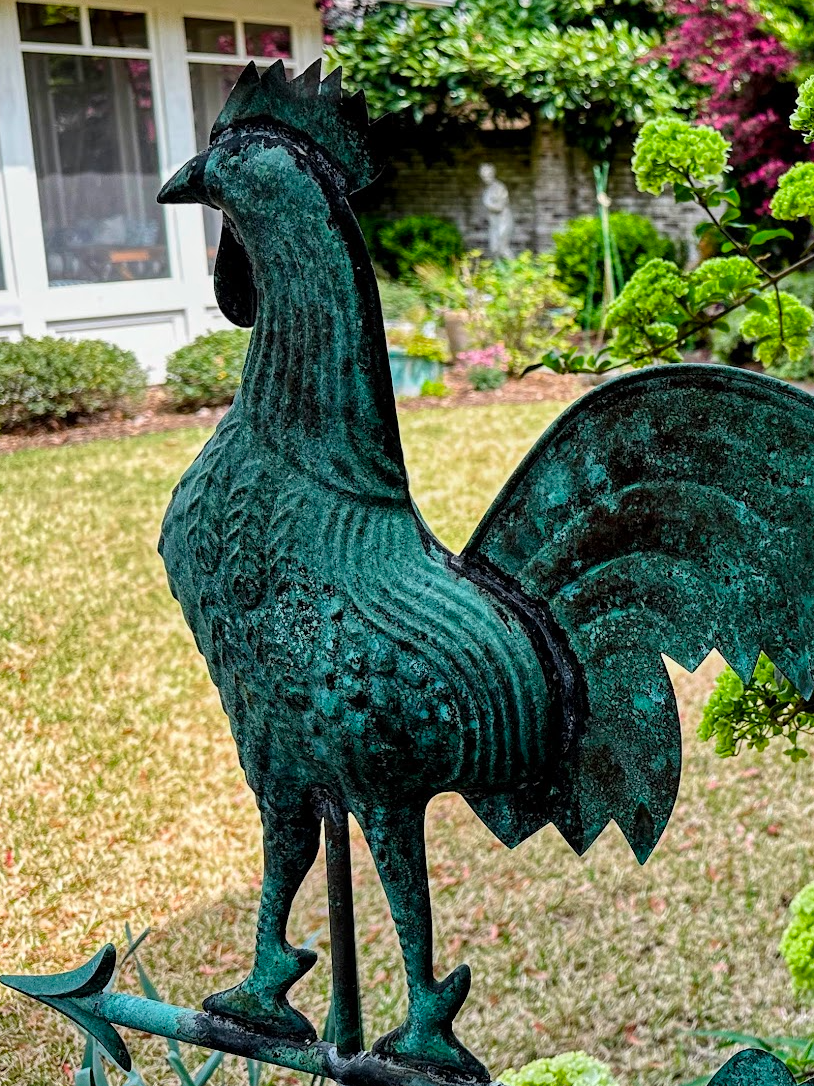
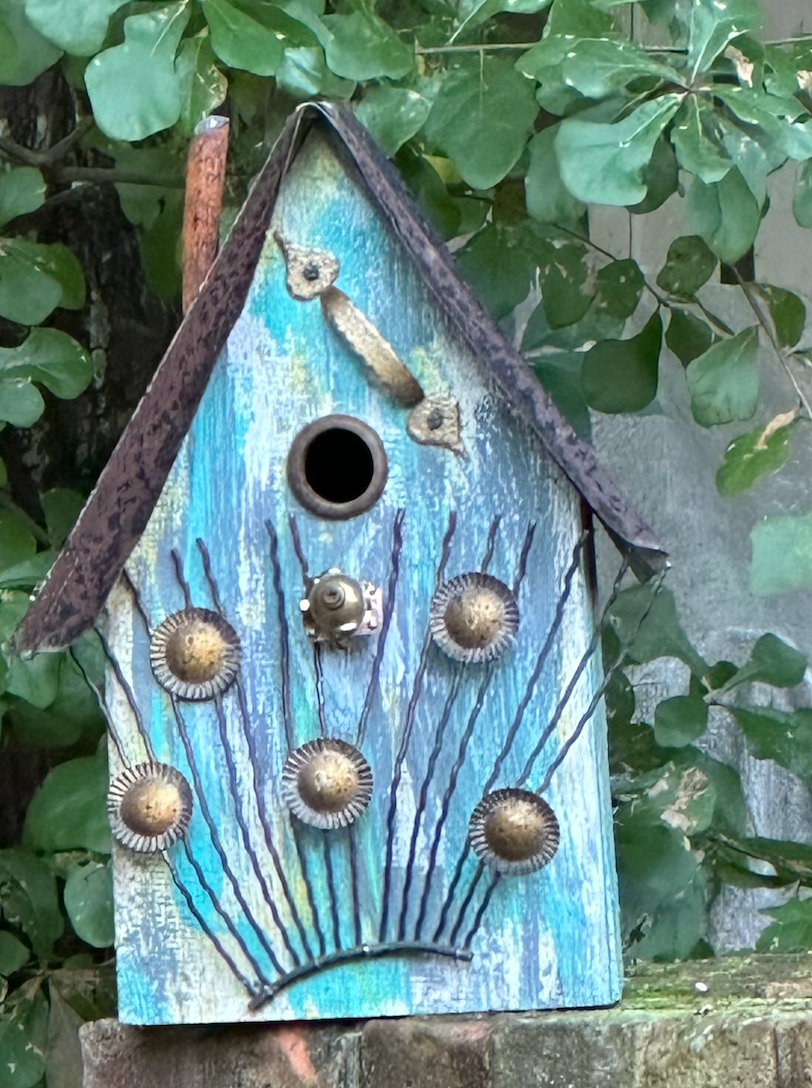
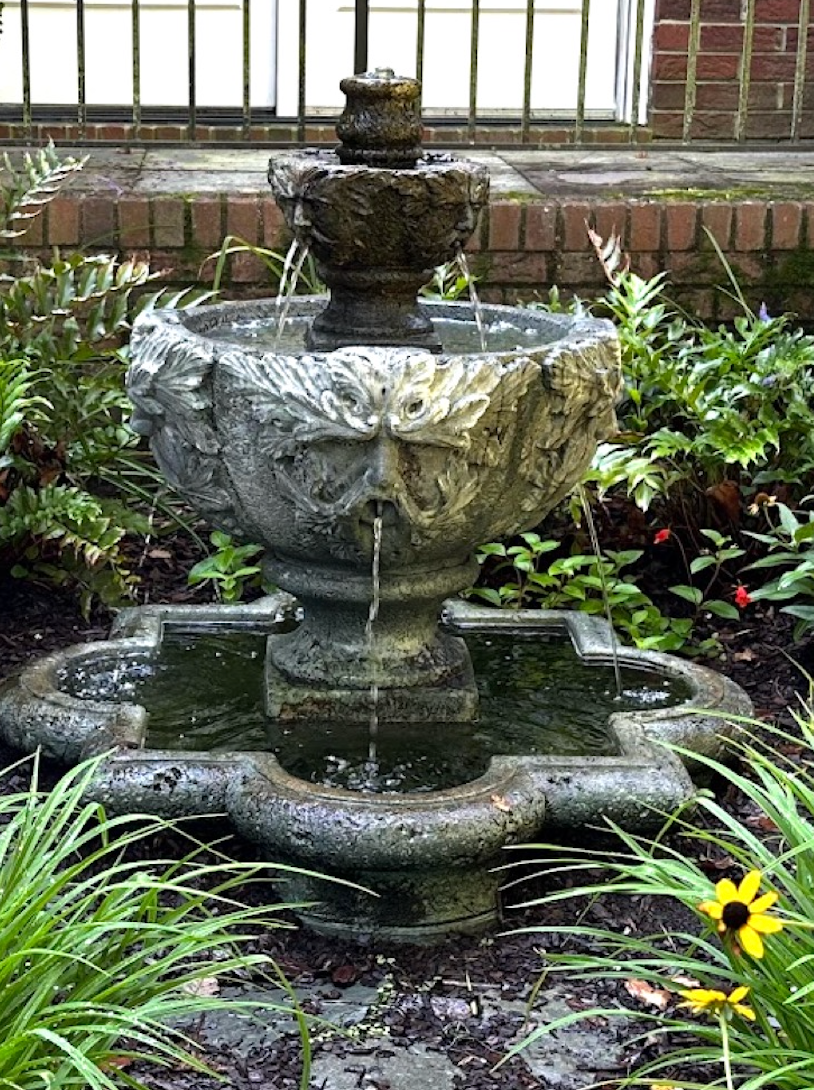
Build Your Garden’s Bones
I started reading a book lent to me by my gardening friend, Susan Hitchcock, who knows a lot more about gardening, gardens, and gardeners than I do. It’s called Two Gardeners: A Friendship in Letters. It’s a gorgeous collection of the letters written back and forth between Katherine S. White, writer and editor for The New Yorker (and the wife of E. B. White) and Elizabeth Lawrence, garden writer of books as well as articles for the Charlotte Observer. In the introduction, Emily Herring Wilson writes that gardeners are often good writers, as these two certainly were. They used writing letters to preserve their memories of what was often fleeting in the garden.
It is far easier to maintain the illusion of a garden in a letter. Which brings us to the idea of the garden as an illusion, for it is the constant hope of the gardener that enriching this bed and planting that shrub will result in an aesthetic experience that lives up to the dream. So, what is the gardener’s dream but a dream of the ideal order in which beauty can be expressed, and loss absorbed?
A dream of the ideal order…I love that.
My mom is always with me in the garden, and I believe she had it right. Build the bones first. By starting with your winter garden, you will create the backdrop and structure for your dream garden all year.
So, go forth and create your dream!
What I Hope to Do with This Series
In the last episode, I told this story. I decided to leave it in here because telling it helped me define who I am and what I am all about in this garden design space.
The other day, I was exploring gardens with friends, and we got to talking about garden clubs. One of them asked, “Do you want to join one?” I said, “Yes I kind of do.” I just like talking about gardening with people who garden. One of them said, “You don’t want to join mine. It’s not on your level.”
I have to say, I was shaken by that. I didn’t know there were “levels” of gardeners. But then, I guess there are given that there are people called Master Gardeners (I’m not one) and Landscape Designers (I’m a hack). And so forth.
Just to be clear, I’m not on a “level.” I just do what my mom taught me and what I have learned from reading and from visiting gardens and talking with other gardeners. With Jennifer’s Home Journal, I am trying my best to provide a little inspiration, a little information, and a lot of encouragement to explore ideas so you can make your spaces yours. I’m not an expert on this or anything else. I’m a learner, just like you. I seek inspiration and crave connection with others who have similar interests.
So, what might you do with any of this? Maybe throw down some stuff in your yard and mess around with spaces and shapes? Maybe go buy some graph paper and colored pencils and mess about on paper? I’d love to see and hear about it!
You know where to find me…in the garden or in the kitchen or in the Wayback building something. I’d love to hear from you!
I’m no expert and I’m not on a “level.” I just do what I have learned through experience, practice, and learning from other gardeners.


